Market Entry Framework: How to Apply in Case Interviews
The market entry framework is a tool to assess whether a company should enter a particular market or introduce new products in existing markets by assessing growth opportunities, capabilities, and challenges. In case interviews , these frameworks are useful templates for market entry cases.
In this article, I will explain how you can apply market entry frameworks in market entry cases using a four-step guide and case examples. Let’s get started!
Table of Contents

Market entry cases in case interview
A market entry is a type of case interview that asks candidates to evaluate and decide whether a client company should enter a particular market. The market entry case is one of the most common types of cases in consulting interviews since, in practice, consultants frequently deal with this type of cases
Among MBB (Big 3) firms , market entry cases are more common at BCG and Bain than McKinsey.
Our Case Interview End-to-End Secrets Program assembled everything you need to know about consulting case interviews and how to pass them, so that’s the best place to go if you have general questions.
Types of market entry cases
There are three commonly encountered market entry cases: New geographic market case, New product category case, and New customer segment case.
However, you also need to be aware that there are countless types of market entry cases and you can face any type of case in your case interview. Each case you receive has certain differences and comes with a different breakdown and solution.
Type 1: New geographic market case
Geographic market entry cases ask candidates to assess whether the business should expand to a new geographical market , for example, if Amazon Go should enter the UK or if Mercy Meats should enter South America.
Type 2: New product category case
On the other hand, product expansion cases ask candidates to assess whether the business should launch new business lines into their existing market , for example, if Disney should launch their own streaming service, or if Walmart should start selling meal kits from its service partners.
Type 3: New customer segment case
Lastly, targeting different customer segment cases ask candidates to assess whether the company ought to consider offering a version of an existing product to a new customer segment , for example, if KFC should serve premium fried chicken for the wealthy or if Gucci should target working class people.
Examples of market entry cases
A French soft drink company, Le Seine, is looking to diversify its holdings by investing in a new fast food chain in the US. You are hired to determine whether they should pursue this path and, if so, how they should go about execution (HBS Case Interview Guide).
The client is a grocery store chain considering whether they should enter the emerging Internet-based grocery shopping/delivery market in the Boston area. This regional chain is currently one of the leaders in northern New England's traditional grocery store market.
In their core market, two competitors have emerged in the Internet/at-home grocery shopping business and are rapidly gaining market share. Should the client enter the market?
Apple, a technology company renowned for its premium smartphones and computers, has predominantly focused on individual consumers and creative professionals. Apple is now contemplating the prospect of expanding its market by targeting the corporate sector. Should Apple venture into the corporate market? If so, how should they do it?
Case interview frameworks – Definition & characteristics
Understanding what a framework is, the characteristics of good frameworks, and how to apply them in case interviews is essential to sounding structured and methodical – two main consulting traits interviewers look for.
What is a case interview framework?
The most important thing to remember when using frameworks to solve a problem is to be FLEXIBLE. Consulting problems are complex and usually, there are no clear-cut, ready-to-use frameworks to solve them. The interviewer looks for context-relevant frameworks, not complicated but inappropriate ones.
Hence, the more you master the “building-blocks” frameworks, the better you can draw specific frameworks suitable to each context. Learn more about frameworks here .
Characteristics of a good framework
When building a framework, you should keep these three priorities in mind:
A good framework is top-down: The problem must be broken down from the generic to the specific, with each hypothesis staying on one level of the issue tree .
A good framework is MECE: MECE is extremely important in problem-solving because it ensures complete coverage of the problem while preventing effort duplications.
A good framework is geared toward isolating the root cause: To isolate the root cause, your framework must strictly follow the problem-solving methodology .
The MConsultingPrep market entry framework
In a market entry case interview , you are expected to evaluate an expansion opportunity (entry into new markets, new segments or new product lines in existing markets), decide whether the client company should pursue it , and, if yes, suggest an entry strategy . The underlying principle of the market entry framework is based on this process.
A market entry framework answers three questions, in order: “Should I enter?”, “Can I enter?”, “How to enter?” .
These ordered questions make up the three steps of a market entry framework: Assessment, Feasibility, and Implementation.
Step 1: Assessment – Should I enter?
The first step is to justify WHY the company should pursue a particular expansion opportunity. To answer “Should I enter?”, you have to make two assessments – market assessment and company assessment .
Company assessment will reveal the company’s internal motivations to expand, whereas market assessment shows the external motivations driving expansion decisions.
Company assessment
The first step after receiving a case is to ask for more information about your client company. Use that data to understand if there are internal motivations driving expansion decisions.
For example, let’s say you asked about revenue and were informed of a declining trend. You know this is a market entry case, so you might hypothesize that the client company’s revenue is declining because their product is at the mature stage of the product life cycle.
If the hypothesis is confirmed, this implies an internal motivation for the company’s expansion to other markets to capture new market shares or introduce new products to capture more revenues from their early life cycles.
Market assessment
The next step is to inquire into the market of interest to pinpoint the external motivations that can justify the need to expand. What is attractive about this market? Is it the market size, or the potential market demand?
If information about the market size is available in the case, this implies that you need to first estimate it .
Sometimes, markets are attractive because of their location advantage , which can save transport costs or enable the client company to obtain cheap inputs .
The open trade environment of a market might also help firms jump trade barriers. Finally, political stability is also attractive for minimizing risks and conducting business sustainably in the long run.
Other information to ask for:
What is the current product portfolio? What is the life cycle of each product? How closely related are the current products?
Who are the customers? How are they segmented?
What are the company’s key strengths and weaknesses?
What are the current distribution channels?
Who are the key suppliers and partners?
Regardless, the most important information to ask for are:
What geographical area will I serve, and how much demand will there be in the market?
What is the market’s growth rate? What are the current trends in the industry?
At what stage of the life cycle is it? Emerging, Mature, Declining?
Who are the existing competitors in the market?
Are there substitute products or potential entrants?
Are there any location-specific advantages that can save transport/ input costs?
Are there any macroeconomic, social, or geopolitical factors to consider?
Is there a key technology involved? How fast are technologies changing in the industry?
After gathering information about the company and market opportunities, do your cost-benefit analysis. By then, you can decide if the company SHOULD enter a new market or not.
If you decide that the company should not enter , you no longer need to answer the other two questions. If you decide that it should enter , move on with the next step.
Part 2: Feasibility – Can I enter?
Remember, only move on with this step if you’ve decided that the estimated benefit of this market entry outweighs the estimated cost.
At this point, you need to assess the FEASIBILITY of entering a new market – does the client company have the financial capacities and capabilities to adapt to and profit from the new market?
Financial feasibility
Figure out whether the client company’s financial situation can cover investment costs . To do this, you first need to estimate the amount of investment required.
You can follow these questions, in order:
What investments are required for this market entry? (R&D, warehouse rent, factory rent, marketing, distribution, etc)
What is the current financial situation of the company?
Can the company fund these investments itself or can it raise the required capital?
Capability feasibility
The company’s capabilities help it secure market share by differentiating it from other competitors in the market.
Examples of capabilities are firm-specific competitive advantages such as patented technologies, efficient logistics & production capacities, local knowledge, a low-cost structure, etc.
Important information to ask for:
Does the company have efficient distribution channels/ logistics?
Does the company have efficient production capacities?
Does the company have a patented technology/design that makes room for no substitution of its products?
Can the company obtain the capabilities it currently lacks?
Step 3: Implementation – How to enter?
This step will be applied if it’s feasible for the client to enter this new market and you must next suggest an entry strategy or an implementation plan. This plan must be specific in terms of timeline, modes of expansion, and execution details.
However, there are some market entry scenarios where the project may just require the first two components, which entails responding to the customer's inquiry regarding whether or not they should enter the market they desire.
Propose a timeframe
Propose a time frame for your expansion strategy. When is the right time for the client company to enter the market? Is there a first-mover advantage at present?
Don’t forget to refer back to the above information about the company’s situation and market opportunities to support your decision.
Propose a method of expansion
Regarding modes of expansion, there are three common strategies:
Partnership: Partnership entry modes are those wherein two (bilateral partnership) or more (network partnership) firms co-join their finance, skills, information and/or other resources to minimize risks. These are joint ventures , licensing , or joint distribution networks .
Organic: Organic entry modes involve those that increase the company’s sales using only internal resources. In other words, they are trade-based entry modes, such as exporting.
Mergers and Acquisitions (M&A): M&A generally occurs when one company directly purchases another company. Together, they form a new legal entity under one mother corporation.
Again, evaluate the information about the company and carefully compare that with the risks of each entry mode to decide on a suitable one. For example, if the client company has a patented technology, choosing a partnership entry mode runs the risk of technological theft.
You should also consider the commitment factor – how much control does the company want over the new market, and how much investment is it willing to make?
With a simple strategy like exporting, you can exit easily but have less control. Meanwhile, with a wholly-owned subsidiary, investment costs are high but you also have more control.
Finalize your execution plan
The final step is to specify your execution plan, containing the key objectives to be implemented. The plan will also need to specify what tasks to be completed, who is in charge of each task, and how they should be carried out.
The final plan will be the final deliverable to the client. The client can then choose to implement it themselves or sign another implementation contract.
The market entry framework – Sample case
Now, let’s apply the framework to a sample case so you can see the flow.
Situation:
Your client company is Mercy Meats, an international plant-based meat producer in the US. The main ingredients in their products are soy protein and heme – a genetically modified ingredient extracted from soy roots that makes their products look and taste identical to animal meat.
Mercy Meats is considering an expansion in South American countries, Brazil in particular, after major successes in the US, Hong Kong, and Canada. Our client would like your help in deciding whether or not to pursue this growth opportunity, and if so, what their entry strategy should be.
We’ll begin by assessing the company – Mercy Meats, and Brazil’s market, to make an entry decision.
Company Assessment
For company assessment, we want to find out if there are any internal motivations specific to Mercy Meats regarding this entry decision. We are told that the only motivation is to satisfy its stakeholders’ expectations, profitability-wise and mission-wise.
Profitability-wise, shareholders want to scale up production to capitalize on economies of scale, thereby maximizing profits.
Mission-wise, the CEO and investors want to reduce the environmental footprint of the factory farming industry, by competing with conventional meat producers and making more consumers cut back on animal meat consumption.
Market Assessment
For market assessment, we will look at external motivations that Mercy Meats seek to justify its entry decision – attractive characteristics of Brazil’s alternative protein market.
What is the market’s size, growth rate, trends, and industry life cycle?
First, we’ll want to know the life cycle of plant-based meat, its market size in Brazil, the market’s growth rate, and trends. The plant-based industry is in its growth stage, with an annual average compound growth rate of 8% globally and 20% in Brazil’s market.
Meanwhile, we’re told that Brazil’s plant protein market size is predicted to reach $30.2 billion by 2023. This is mainly attributable to a strong shift in attitude towards vegetarianism among young Brazilian consumers. With a strong growth rate driven by positive attitude shifts, this market is an attractive place to be.
Who are the customers? What are their needs and preferences?
We can broadly construct a portfolio of our customers: people who are health-conscious, high-income, concerned about animal welfare, would buy plant-based protein as a substitution for animal protein, and enjoy similar tastes of real meat.
The interviewer might also inform us that our customers could be swayed by lab-grown meat for its real taste and “real meat” brand, although this technology is yet to be marketable due to its high price and environmental concerns.
The competitors of Mercy Meats will consist of any businesses meeting the same customer demand mentioned above. We’re told that direct competitors in the market are local plant-based brands, however, the tough competition will be posed by conventional meat players (such as Marfrig or JBS), who are starting to develop their own plant-based products.
Here, we should talk about events that can broadly affect our entry strategy. For example, we might point out that complex bureaucracy and lack of transparency are the two biggest barriers to doing business in Brazil.
As a response, the interviewer might say that Brazilian governments are committed to reducing bureaucracy by simplifying their tax structure and investing in public services digitalization (such as digitized tax fillings). This is a positive improvement, making Brazil a more attractive place to do business. You can raise other concerning issues in a similar manner if needed.
To summarize, we have sufficient reasons to decide that Mercy Meats should enter Brazil . Brazil’s plant-based protein market is overall attractive, with a strong predicted growth rate and, as a leading soy producer, can create a cost-saving advantage for the company.
The biggest concern so far is competition from well-established meat players, and lab-grown meat competitors in the near future.
Step 2: Feasibility – Can I enter?
Now that we’ve decided that entering Brazil is beneficial for Mercy Meats, we need to see whether the client company is equipped with what’s required to do so, capability-wise and finance-wise.
First, we need to understand whether Mercy Meats has the capabilities (competitive advantages), to sustainably compete in the new market.
In the US, Canada, and Singapore, Mercy Meats have very efficient logistical channels, with low warehouse capacity, minimal shipping time, low inventory turnover rate, and a high number of orders relative to all of its major competitors. The company definitely has the required capability to replicate another efficient logistical channel in Brazil.
Can the company produce premium quality products at a lower cost than its competitors?
Mercy Meats products, Mercy Burger, Mercy Sausage, and Mercy Pork, are much more expensive compared to animal meat products in Brazil. For example, one Impossible Burger pack weighing 1.4kg is currently priced at around $30, nearly 4 times higher than the same amount of beef (around $8 per 1.4kg) in Brazil.
However, Brazil is the leading exporter of soybean in quantity due to its low price and premium quality. Hence, if the company can take advantage of the low soybean input in Brazil and can scale up its production, a more reasonable product pricing can be achieved.
Does the company have a patented technology/design that distinguishes it from other competitors?
Mercy Meats owns a patented technology over its heme ingredient, a soy root-extracted ingredient that makes its products taste and look almost identical to animal meat. In fact, Burger Queen, a major fast food chain, chose to partner with Mercy Meats in the US because its products taste much more like real meat than that of Beyond Meat, Mercy Meats’ biggest competitor in the plant-based industry.
What is the current financial situation of the company? Can the company fund the investments itself or can it raise the required capital?
Next, we will look at how much investment is required and whether the company can financially cover it. The total investment cost is estimated at $80 million, while the expected return is over $180 million in 2 years.
Finance-wise, the company is doing really well, with average yearly revenue of $151 million. Mercy Meats also attracted many investors in the past, with $1.4 billion in total funding, of which $200 million was acquired in 2020. These figures exhibit investor confidence in the company, which implies a high chance of getting more funding in the near future.
After analyzing the facts and evidence, we can conclude that Mercy Meats clearly has the finance and capability to enter Brazil . Hence, we proceed with the decision to advise the client to say “Yes” to the entry decision.
The final step is to formulate an entry strategy, which includes deciding the implementation timeline, choosing the methods of expansion, and drafting an execution plan. We will examine each aspect, in the above order.
When is the best time to enter Brazil’s market?
The best time to enter Brazil is right now. We’ve observed that our major competitors, such as Marfrig, have started developing their own lines of plant-based meat. These competitors have better local knowledge than our client company and an already widely-recognized brand name in Brazil. Mercy Meats needs to move fast if it wants to secure a fair share of the plant-based meat market.
Which method of expansion is the most suitable?
To effectively gauge demand, Mercy Meats should consider expanding under trade-based modes, exporting in particular, and growing organically first. After that, it is recommended that Mercy Meats establish its own subsidiary, to have better control of two aspects: technology and market.
First, partnership modes are risky due to the potential of technological theft, subsidiaries or M&A modes can eliminate this risk, although they require more investment. Second, establishing a production subsidiary will enable the company to exert more control over the target market, by quickly adjusting production to customers’ needs and reducing logistic costs to be more cost-competitive .
What is the execution plan?
Finally, we need to develop an execution plan.
What: The breakdown of tasks in the overall implementation plan, for example, establishing partnerships for exporting, marketing the product, setting up the factory, etc.
Who: Who will be in charge of the aforementioned tasks? What are their deliverables?
How: What are the targets for each task, what are the expected quality standards that align with the key objectives?
Market entry case: examples & guidelines
Case 1: medicare plus.
Our client, MediCare Plus, is considering opening a new medical clinic in the affluent Riverside neighborhood of Los Angeles. Riverside is known for its high-income residents, including individuals from various socio-economic segments.
The client aims to diversify their healthcare services and tap into the lucrative Riverside market that aligns with their expertise. They seek your guidance on whether to proceed with this investment.
Should MediCare Plus open a new medical clinic in Riverside, Los Angeles?
Step 1: Assessment - Should I Enter?
Current Capability: Can MediCare Plus handle this expansion given its current resources and expertise?
Strategic Alignment: Does this expansion align with MediCare Plus' long-term goals?
Market Size: How big is the Riverside healthcare market?
Market Growth: Is the Riverside healthcare market expected to grow?
Competitors: Who are the competitors in Riverside's healthcare market?
Step 2: Feasibility - Can I Enter?
Financial Feasibility
Initial Investment: What's the cost to set up the new clinic?
Operating Costs: What are the ongoing expenses, including salaries, maintenance, and utilities?
Revenue Projection: How much revenue can we expect from different patient segments and specialties?
Capability Assessment
- Facilities: Can MediCare Plus handle clinic setup and management in Riverside?
- Financing: How can we finance this expansion?
- Doctor and Patient Attraction: Can we attract top doctors and patients to Riverside?
Step 3: Implementation - How I Enter?
Key Milestones: What are the critical milestones and deadlines for the expansion?
Responsibility: Who is responsible for each task?
Tasks: What specific activities are needed for a successful launch?
Methods: How will we execute each task effectively?
Approaches: What strategies and methods will we use for marketing, patient acquisition, and operations?
Case 2: TechGizmo Inc .
Our client, TechGizmo Inc., is a leading manufacturer of smartphones and consumer electronics. They have been experiencing steady growth, with revenues of $500 million last year and a healthy profit margin of 15%. However, they are concerned about the cyclical nature of the consumer electronics industry, which can lead to fluctuations in their business.
The CEO is considering entering the market for smart home devices. They want your opinion on whether this would be a good strategic move for TechGizmo Inc.?
Current Capability: Can TechGizmo handle this expansion with its existing resources and expertise?
Strategic Alignment: Does this expansion align with TechGizmo's long-term goals and expertise in consumer electronics?
Market Size: How big is the smart home devices market in Westwood?
Market Growth: Is the smart home devices market in Westwood expected to grow?
Competitors: Who are the competitors in Westwood's smart home devices market?
Initial Investment: What's the cost to develop and launch the new line of smart home devices?
Operating Costs: What are the ongoing expenses, including production, marketing, and distribution?
Revenue Projection: How much revenue can we expect from different customer segments and product lines?
Product Development: Can TechGizmo efficiently develop and manufacture smart home devices?
Financing: What are the financing options available for this expansion?
Customer and Retailer Attraction: Can TechGizmo attract both customers and retailers to sell their smart home devices in Westwood?
Step 3: Implementation
Key Milestones: What are the critical milestones and deadlines for launching the new line of smart home devices?
Responsibility: Who is responsible for each task, from product development to marketing?
Tasks: What specific activities are needed for a successful product launch?
Methods: How will we execute each task effectively, from marketing strategies to distribution?
Approaches: What marketing strategies and distribution methods will we use to promote and sell our smart home devices in Westwood?
What do you think about the market entry framework sample presented above? It’s super detailed, isn’t it? Even so, it’s just theory.
The only way to master the market entry framework is to practice. You need to learn and understand the fundamentals of market entry cases.
And it would be best if you had any consulting experts review your performance. Reach out to our ex-consultants , who can give you concrete feedback on your answer to a specific market entry framework case.
Meet your coach today to start sharpening your skills! They’ll help you determine your weak areas and suggest effective improvement methods.
Scoring in the McKinsey PSG/Digital Assessment
The scoring mechanism in the McKinsey Digital Assessment
Related product
/filters:quality(75)//case_thumb/1669783363736_case_interview_end_to_end_secrets_program.png)
Case Interview End-to-End Secrets Program
Elevate your case interview skills with a well-rounded preparation package
A case interview is where candidates is asked to solve a business problem. They are used by consulting firms to evaluate problem-solving skill & soft skills
Case interview frameworks are methods for addressing and solving business cases. A framework can be extensively customized or off-the-shelf for specific cases.
Market Entry Framework: How to Use It + Consulting Case Example
- Last Updated May, 2024
Rebecca Smith-Allen
Former McKinsey Engagement Manager
Company X wants to know if they can profitably introduce their widget to the Chinese market.
Company Y wants to leverage its knowledge of the North American fast-food market to introduce a new restaurant format. How should they do it and how long will it take to reach profitability?
Have you read case interview examples that sound like these?
Of course you have, because all successful businesses want to become more successful by expanding into new markets, so there are many case interview questions on this topic.
Because of this, it’s important that you have a thorough understanding of the market entry case framework.
We’ve got you covered!
In this article, we’ll:
- Discuss market entry case interview,
- Break down the framework into 4 easy steps,
- Provide an example of a market entry case,
- Provide tips on using the framework, and
- Point to additional resources to help you with the market entry framework and cases.
Let’s get started!
What is a Market Entry Case Interview?
Our Ultimate Guide to Case Interview Prep goes through everything you need to know about consulting case interviews and how to pass them, so if you have general questions, that’s the best place to turn. But if you’re ready to move on to market entry cases, read on. If you’re asked a market entry case question, there’s a lot of information you’ll need to cover. You’ll be better prepared if you practice this type of case. A market entry case starts with a company deciding to enter a new market.
- They could sell a new product into an existing market. Example: Netflix produces its own content to air over its existing streaming service.
- Or they could take an existing product to a new geography. Example: Starbucks enters the Chinese market.
Whether a company is contemplating entering a new geography or a new product-space, the decision is a big one. The CEO will face complicated questions like:
- Is the market profitable?
- Does the company have the skills needed to compete in the new market?
- Does it have the financial resources needed to successfully enter the market?
- Should the company create the capabilities to enter the new market in-house? Buy a company already competing in the market? Form a joint venture with another company?
- What regulatory hurdles might they face?
The high stakes and complexity of market entry decisions are the reason corporate executives facing these decisions often turn to consultants for help.
Nail the case & fit interview with strategies from former MBB Interviewers that have helped 89.6% of our clients pass the case interview.
Breaking Down The Market Entry Framework Into 4 Easy Steps
Step 1: assess the target market.
Assessing the market is step 1 because if the new market isn’t profitable (or won’t be profitable in the future), there’s no point in going further with this case.
Questions to ask during the assessment of the target market include:
- What is the size of the market in terms of revenue?
- What is the market’s growth rate?
- What is the profit margin on sales in the market?
- What share of the market would the client need to break even? Become profitable?
Step 2: Assess the Client’s Capabilities
Questions to ask during the assessment of the client’s capabilities include:
- Do they have the technical skills?
- Is their cost structure competitive?
- Do they have the necessary sales or distribution channels?
- Can they get whatever capabilities they currently lack?
- Are there barriers to entering the market?
- Do they understand the customer segments in the new market?
- Can they tailor the product or service to the requirements in the new market so they can compete effectively?
- What government regulations will be encountered?
Step 3: Analyze Client Resources Relative to the Investment Needs & Expected ROI
Questions to ask while analyzing the client’s resources relative to the cost of market entry and expected ROI:
- Research & development
- Manufacturing & warehouse capacity
- Marketing launch & sales/distribution
- How long will it take to pay back the company’s initial investment?
- Does the company have or can it raise the required capital?
Step 4: IF Conditions for Market Entry Are Good, Then Determine the Best Strategy to Use
You’ve decided the client in your case should enter the market.
Again, the decision of whether to enter the new market is only part of the answer. The company must decide how to enter it.
For a new product or service, they should ask whether they should:
- Create the capability to build the new product or provide the new service in-house?
- Partner with someone already in the market?
- Buy or license intellectual property?
For geographic expansions they need to ask whether they should:
- Export to the new market from their home country?
- Build a greenfield presence in the new country?
- Partner with a company that already has a presence in the target market?
- License their brand to franchisees?
Questions to ask when determining the best entry strategy:
- Are there barriers to entry in the market? Intellectual property? Regulatory approval?
- Can the company overcome these barriers on their own or will they need to partner to do so?
- How important is timing? Is there an advantage to early market entrants? How fast do they need to have a product in the market to win?
- Will partnering allow the company to enter significantly faster than building capacity in-house?
Example of The Market Entry Framework: KFC Enters China
Today, KFC has over 5,000 fast-food restaurants in China . It’s the most popular fast-food chain in the country.
How did the company enter the market to achieve this success?
When KFC first entered the China market, the success of southern-style American fried chicken in the China market was no guarantee.
The restaurant needed to transfer its successful North-American business model to the new market.
But it also needed to take into account different consumer tastes, find promotional advertising that would appeal to the Chinese consumer, deal with regulations that required that Western companies to partner with Chinese-owned companies in order to enter the market, and more.
Let’s look through the KFC China example using the market entry framework.
Yum! Brands first entered the China market in 1987. At that time, the China market was growing quickly. The country’s middle class was expanding and was receptive to western brands. The Chinese restaurant market was dominated by a large number of street vendors and small, family-owned, single-location restaurants. In comparison, growth in the North American market was slowing and there was a high level of competition from McDonald’s, Burger King, Wendy’s, Domino’s Pizza, and other restaurants. The Chinese market provided an opportunity to enter a market without well-entrenched national chains of fast-food restaurants and capitalize on the market’s growth.
KFC was positioned as the second-largest fast-food chain in the U.S. by number of stores . It had a winning formula of providing high-quality food at a competitive price and marketing it well. But KFC knew nothing about the China market. The company had to answer important questions like:
- How to tailor their menu to Chinese tastes?
- What segment of the market to target?
- Where to locate their restaurants?
- How to develop a supply chain in the country?
The challenge facing KFC can be seen by the fact that when they first entered the market, their popular slogan “finger lickin’ good” was mistranslated as “eat your fingers off.” Gaining insight into the Chinese consumer was a critical hurdle to success in this market. At that time, western companies had little experience with dealing in the Chinese communist government. But because the government required western companies to enter the market through joint ventures with Chinese-owned companies, KFC knew they would find help with these decisions by finding the right partner.
KFC considered entering the China market to be an important strategic investment to maintain its revenue and store growth despite high levels of competition in the North American market. Their success in North American meant they could allocate substantial funds to the market entry in China despite the fact that it would take years for their investment to pay off.
As mentioned above, KFC was required to partner with a Chinese-owned company. They found a partner that had strong connections with the Communist government to ensure that they would be able to overcome regulatory problems. Their partner also helped KFC to identify its target market as the middle-class consumer who was interested in western culture. Their sit-down restaurants had a reputation for cleanliness which helped to set KFC apart. In the early days, KFC restaurants also leveraged the fact that they were a unique and exciting experience, a view into American culture. KFC China’s menu includes many items an American customer would not be familiar with, such as lotus roots, congee, and soy sauce wings. The restaurant had a 40-page menu because of the Chinese consumer’s preference for variety. Their promotion was tailored to focus on elements that the local culture valued, such as respect, love, and support for the elderly. The chain’s success in China depends not only on the taste of its food and its advertising, but also on the speed and convenience of its service. These attributes were as important to winning in the China market as tasty chicken. Yum China has been so successful that it has been spun off from YUM! Brands as separately listed stock on the New York Stock Exchange.
Tips On Using The Market Entry Case Framework
1. look for market entry cases buried inside other types of case study interviews..
If a company is looking for growth, market entry is one way they might achieve it, so your revenue growth case could turn into a new product or new geographic market case.
2. Ask your interviewer questions and take good notes on their answers.
Market entry cases require a lot of data–market growth, cost of entry, client capabilities. You’re likely to miss important information if you try to solve the case just through brainstorming and your own knowledge of the industry. Don’t be afraid to ask questions.
3. Don’t only consider whether the target market is attractive .
Look at all 4 elements of the market entry framework. Entering an attractive market without the right capabilities will lead to substantial losses and a CEO being fired.
4. Identify alternative market entry strategies and evaluate one relative to another .
For example, compare the advantages of a greenfield operation (full control over the business model and quality) versus partnering with a company with a presence in the local market (knowledge of the local consumer, speed). The comparison of one entry strategy to another can make the best choice clear quickly.
Additional Resources to Help You With the Market Entry Framework and Cases
This McKinsey article: Beating the Odds in Market Entry is a great resource for those who want to dig deeper on this subject.
In this article, we’ve covered:
- What market entry case interview looks like,
- Breaking down the framework into 4 easy steps,
- A market entry case example,
- Tips on using the framework, and
- Additional resources to help you with the market entry framework and cases.
Still have questions?
If you have more questions about market entry, leave them in the comments below. One of My Consulting Offer’s case coaches will answer them.
Other people prepping for consulting case interviews found the following pages helpful:
- Common Types of Case Interviews
- The Profitability Framework
- Case Interview Frameworks
- Business Situation Framework
- Market Sizing Cases
- M&A Case Study
- Revenue Growth Case Interview
- Cost Reduction Case Interview
- Pricing Case Interview
Help with Case Study Interview Prep
T hanks for turning to My Consulting Offer for advice on the market entry framework. My Consulting Offer has helped almost 89.6% of the people we’ve worked with get a job in management consulting. We want you to be successful in your consulting interviews too. For example, here is how Emma was able to get her offer from Bain.
Leave a Comment Cancel reply
Save my name, email, and website in this browser for the next time I comment.
© My CONSULTING Offer
3 Top Strategies to Master the Case Interview in Under a Week
We are sharing our powerful strategies to pass the case interview even if you have no business background, zero casing experience, or only have a week to prepare.
No thanks, I don't want free strategies to get into consulting.
We are excited to invite you to the online event., where should we send you the calendar invite and login information.
Mastering the Market Entry Framework for Case Interviews
Table of contents.
Consulting firms use a special type of interview, called a case interview , to test whether candidates have the skills to understand and solve real business problems.
One common example of a case interview question is a market entry question. And this covers both launching new products and entering new geographies, so it’s considered one of the most challenging types of case interview questions.
In this article, we will teach you how to recognize and ace market entry case interview questions. And you can also check out our guide to profitability case interview questions too.
Overview of the market entry framework
What is a case interview framework.
A framework is a template that can be applied to break down and solve case study questions. It aids candidates by giving them a clear approach to resolving the case question they are given.
However, frameworks are just a starting point. They should be customized according to your own thinking and understanding of the case question.
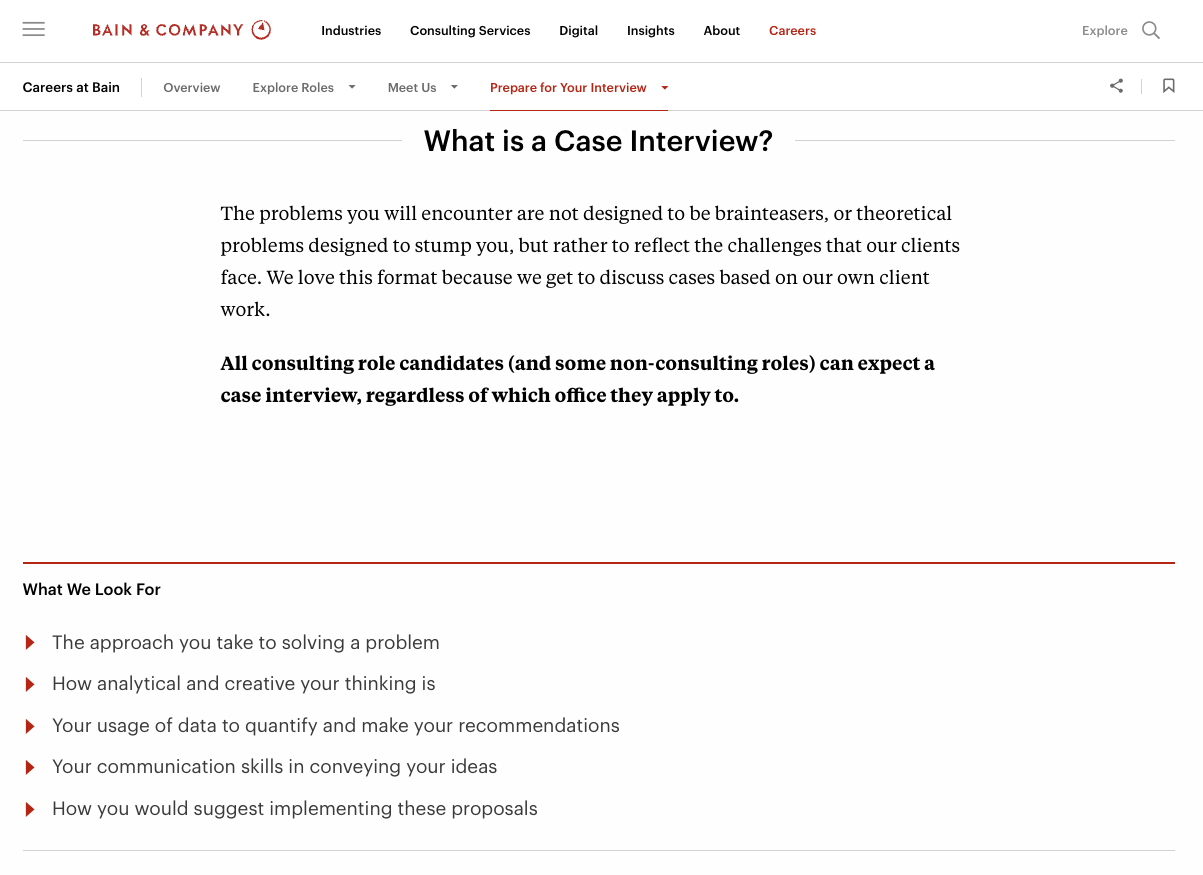
What is the market entry framework?
Market entry framework is a tool to assess and evaluate the viability of entering a new market for a company, this could be the development of a new product or entry into a new geography.
There are 2 main types of market entry cases:
- Geographic Entry : These types of cases ask the candidate to evaluate whether a company should venture into a new geography. For example, standard expansion, joint ventures, mergers, and acquisitions. For example, Lyft might want to venture into Europe or Amazon might want to expand its business into Asia by purchasing a local distributor.
- Product Entry: These types of cases ask the candidate to evaluate whether a company should diversify its product range or launch a new product line. For example, Pepsi Co might be looking to expand into the alcoholic beverages market or Tesla might be looking to expand into the airline industry.
How to apply the market entry framework
There are four steps to apply to the market entry framework in a case interview, including:
- Desirability: Do we want to enter the market?
- Feasibility : Do we have the right people, processes, and technology to enter the market?
- Viability : Can we make the market entry business case work?
- Execution plan : How do we enter the market?
Step 1. Assess the target market (desirability)
The first step is to assess if you should be entering the new market. You should ask questions like:
- How big is the revenue opportunity?
- Is the target market growing and how quickly?
- Are there desirable customer demographics in the target market?
- What is the competitive landscape in the target market?
- What stage of the industry lifecycle is the market in?
- What share of the market can we reasonably expect to capture?
Step 2. Evaluate internal capabilities (feasibility)
The second step is understanding whether our company has the internal capabilities to enter the market successfully. You should ask questions like:
- Are our current product offerings / new product offerings suitable for the target market?
- Do we have an appropriate organizational structure and operating model for the target market?
- Do we have sufficiently robust processes to scale up successfully?
Step 3. Analyze investment case (viability)
The third step is determining whether it makes economic sense to enter the new market. You should ask questions like:
- What are the estimated costs and revenue of entering the new market?
- What is the forecast payback period for any investment?
- What is the expected ROI of entering the new market?
- What are the main risks? (e.g. technological, legal, etc)
Step 4. Build an execution plan
Once you have identified and shared key considerations for market entry to your interviewer, they will often ask you how the company should enter the market.
To answer this accurately, you need to build an execution plan.
The execution plan requires you to synthesize all the information you have gathered so far and make recommendations as to how the company should enter the market.
The key questions you should answer in your execution plan include:
- How should you expand into the new market? In the case of a product expansion question, this is build vs partner vs license. And in the case of a geographic expansion question, this is expand organically (greenfield) vs enter a joint venture vs partner vs acquire a competitor.
- What is the timeline? Propose a timeline for entering the market based on the market and competitive dynamics.
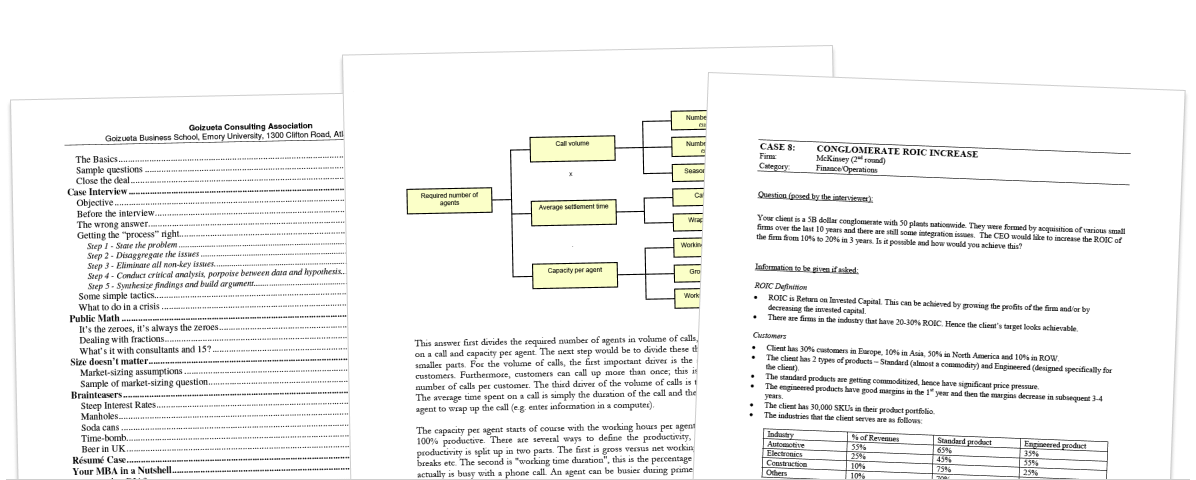
Download 183 practice case interviews and over 851 pages of interview guides
The ultimate case study preparation package. Download practice cases from McKinsey, BCG, Bain, Harvard, Kellogg, Columbia, INSEAD, Cornell, and more!
Example market entry case interview questions
Example 1: grocery chain.
A grocery chain in New England is considering offering an Internet delivery service (i.e., groceries can be ordered via the Internet and delivered directly to your home). Including the client, there are three main grocery chains in the area. One of them has already entered the Internet market. The only other grocery store currently offering Internet delivery service in the U.S. is a Midwest store.
Should the client enter this market? If so, what issues would they face? If not, how should they protect their market share?
Example 2: Corn feed company
A corn feed company has eight manufacturing plants located in the Midwest. These plants service the entire United States. Their plant in Ohio is in need of refurbishing. The company has four possible options:
- Refurbish the existing plant
- Build a larger plant at the current location
- Build a similar size plant at a new location
- Build a larger plant at a new location
Which is the best option for this plant?
Example 3: Gas manufacturer
Your client is a gas manufacturer. Currently, the client owns and operates its gas plants nationwide. They have hired you to investigate whether they should enter into the business of running 3rd party gas plants. How will you structure the analysis of this case? Should the client enter or not enter into this business?
Example 4: Construction firm
An overseas construction firm wants to expand by establishing a presence in a growing U.S. regional market. What factors should it consider? How should it go about doing this? What factors are critical for its success?
Example 5: Chicken vitamin manufacturer
Your client is a chicken vitamin manufacturer. The vitamin helps increase the size of chicken breasts and reduce fat content. Should they enter China?
Example 6: Travel agent
An Israeli travel agent has been extremely successful. His primary source of revenue is customers who fly to and from the U.S. He manages to fill up over two planeloads on a daily basis. Given his success, he is considering buying an aircraft and flying the U.S.- Tel Aviv route himself. What advice would you give him?
Example 7: Food processing company
You have been hired by a food processing company that recently introduced a new hot dog to the market. Sales in the first two weeks have far exceeded the marketing department’s projections. Your client thinks he may need to add more capacity. What advice would you give him?
Example 9: Airline
A major American airline is considering establishing new routes from Tokyo to several sites in the United States. Would you recommend this action to your client?
Market Entry Case Studies - A Comprehensive Overview

Market entry cases are a recurring theme in the management consulting interview process.
This is because consultants will frequently deal with market entry when working on real projects – which in turn means they are likely to base interview case studies on recent market entry work.
Releasing new products and entering new markets is fundamental to growing any business over time. Thus, CEOs across all sectors will be consistently confronted with market-entry issues - many of which then prove complex enough to mean bringing in the consultants!
Whilst this article will aim to give you a clear overview of market-entry theory and methods , a fully exhaustive treatment is impossible here. For a comprehensive view of market-entry and related issues, your first stop should always be our MCC Academy course .
Market entry: definition
So, what exactly is market entry?
In very simple terms, it’s exactly what you would expect: the process by which a company enters a new market.
In practice, things are a bit more complicated. However, the fundamental principle that the company is getting itself into a novel situation remains. Market entry scenarios (and implicitly market entry cases) can be divided into the following broad categories:
Geographical scenarios: when a company is trying to introduce a product in a new geographical region. An example of this would be Red Bull moving into the US market.
Product diversification scenarios: when a company is introducing a new product to an existing market. The attempts by Xerox to sell computers to their customers is one such instance.
New customer segment scenarios: when a company targets a new segment of an existing market with its products. For example, if Old Spice made a fragrance for women.

Covert Market Entry Cases
As mentioned, because market entry cases are interconnected with growth, you might come across an ‘incognito’ market entry case, where a consideration of market entry is necessitated to solve the initial problem.
This means you might come across a question - such as “How can Heineken increase its revenues?” - which is not explicitly about market entry, but for which any one of the market entry scenarios could be applied.
Old fashioned market entry frameworks can be hard to adapt to these trickier “hybrid” cases.
This general problem where idealised frameworks encounter complex cases is why we at MCC always teach you how to structure your answers for yourself - so that you can logically break down the questions you are given and deal with any market entry aspects in a flexible manner to fit the particular scenario.
What to consider when thinking about market-entry?
A typical market entry case might sound like this:
Ecobank is a South African bank looking to expand by moving into the Congo? Should they do this?
So, how should we tackle it?
As always, the most important thing to remember is that each unique case requires its own unique approach, tailored specifically for the situation at hand .
However, there are a few elements that recur in most market-entry cases and that are helpful when tailoring our analysis. Thus, we need to consider:
- The Company
- Strategies to enter the market
We’ll give a brief primer on each of these three elements over the rest of the article.
1.The Market
The first step for a company in any market entry scenario is to understand the market it’s engaging with.
In the real world, businesses continuously engage in market research, using different techniques in order to appreciate their market context.
For an example of how this then applies in a market entry context, McKinsey recommends having a reference class of previous entrants to similar (and sometimes different) markets. By doing so, companies can analyze the results of this class of previous entrants and draw better conclusions regarding the potential outcome of their endeavor.
McKinsey give the Segway as a case of failed market entry that could have been prevented. The company failed to anticipate that Segways would be confined to running on pavements rather than roads. Ultimately, they sold only 6000 units in its first 21 months as opposed to the 10,000 per week they had predicted.
If the sellers had evaluated a reference class including not only vehicles such as automobiles, fuel cell cars, hydrogen cars, but also technologies that were dependent on infrastructure like high-definition television and telephones, then Segway’s market entry might have been more successful.
However, these studies take time and money, so companies have to consider carefully what areas to inquire into.
In the same way you, in your case interview, need to think through what questions you want to ask about the market.
An unstructured, “laundry list” approach, where you just ask whichever questions come to mind will most likely irritate the interviewer. In the real world you need to be efficient when gathering expensive-to-acquire data, so asking efficient questions in the interview will be strong evidence that you can do so when it matters as well.

1.1. Market size
The first thing to determine is the size of the market being targeted. In some interviews this might be given to you as an existing figure. However, you will often have to estimate market size (read in our article on estimation ).
For example, imagine a company producing confectionery wants to expand its ice-cream business into the city of Milan. Before it does so, it needs to evaluate the potential client base.
You might start by guessing the population of Milan and then dividing it into people who are lactose intolerant (and therefore cannot eat ice-cream) or people who do not like ice-cream and people who are not lactose intolerant and do like ice-cream. You can make the assumption that each category is about 50% of the total population (remember to sense-check later). One segmentation might look like this:

Of course, there will be more than one way to segment and you will have to determine which one is most appropriate for your case. In the example above, for instance, you could have opted for a segmentation based on the age of population. As discussed in our full-length article on segmentation , make sure always to use a MECE segmentation scheme.
1.1.1. The Market Cycle and Growth
Market size is seldom static. Once you have determined (or have been given) the market size, you will have to understand how it will change over time – that is, you need to determine the market growth rate .
For example, a tech company seeking to launch a new smartphone can calculate current global demand for handsets, but will also need to factor in likely future demand as consumers in developing economies become wealthy enough to afford to buy.
Typically, the interviewer will be able to provide you with information on market growth on request.
A market goes through several phases and usually, the further along in its life cycle it is, the less likely it will be for the company entering it to make profits.
Therefore, a market early in its life cycle presents more opportunities for entrants . For example, Apple registered huge revenues with its pioneering entry into the smartphone market.
Normally, a company should avoid entering a declining phase, as this means that consumer demand for a certain service or product is dwindling or new alternatives have rendered it obsolete.
However, fast-growing markets also experience severe shakeouts – which means that, after a period of massive expansion, one of consolidation generally follows. At this stage, bigger, stronger companies use their resources to acquire or get rid of weaker ones.
Additionally, the first mover’s advantage – that is entering a certain market before the competition does – will not always translate to higher profits .
Rather, there is a high chance that companies entering later will learn from the mistakes of the first movers. Later entrants will then leverage that negative experience into improving their product, which will likely lead to higher profits.
While Google’s position as the search engine might seem perennial, in fact it climbed to the top by learning the does and don’ts from pioneers like Altavista and Ask Jeeves.

1.2 Market dynamics
Economist Michael Porter argued that, to understand a market, you need to understand the various forces that can put pressure upon it and how they function. He divided these up into five forces:
- Buyers’ power
- Suppliers’ power
- Threat from substitutes
- Threat from new entrants
- Industry rivalry
Porter’s idea can be captured visually as follows:

Let’s look at what each of them means and how they interact with one another and the market as a whole.
1.2.1 Buyers’ power
The main things you need understand about buyers when entering a new market are:
How many there are
Whether the products they are purchasing are generally available (commodities) or unique
These factors are significant in establishing the influence that buyers can have on the market. As Porter explains, there are a few scenarios in which buyers’ power is high. These include:
When buyers purchase in bulk, their purchase power is concentrated . For example, large soft drinks manufacturers purchasing aluminum cans have the upper hand because they buy in bulk and can dictate the price.
When the products they purchase are not differentiated and therefore can be sourced from multiple suppliers. For example, in the steel industry, the product is virtually identical and can be bought from many manufacturers.
When the products purchased make up a high fraction of the cost of the buyers’ own product . Naturally, in this scenario, the buyer will be very conscious about the price, as it will impact their own pricing as well. For a car manufacturer, the more expensive the steel the car is made of, the more expensive the car. This will mean suppliers will have to keep prices low to attract any purchases in the first place.
1.2.2 Suppliers’ power
The same three factors are equally important when considering suppliers:
Their number
How big they are
Whether they are dealing in unique products or commodities
These also determine buyers’ power in the market. According to Porter, buyer’s power is high when:
There are only a few suppliers and they are concentrated . Again, the soft drinks market is a perfect example of how a few major players can dictate prices. Companies that bottle soft drinks have very little choice when determining their suppliers and must accept the price they dictate.
Suppliers offer a differentiated product and/or the switching costs to a different product are high . Where a school’s entire teaching infrastructure is built around Google Classroom, associated costs will make them reluctant to switch to a different product.
Suppliers are not forced to compete with other products. For instance, furniture manufacturers can choose whether to make tables out of steel or aluminum, which keeps in check the prices of companies producing each metal.
For a detailed analysis of the power of buyers and suppliers, check out the Marketing 101 and Strategy 101 sections of the MCC Academy .

1.2.3 Threat from substitutes
The existence of substitutes or alternatives to products will also determine the profitability of a market. The existence of one or more substitutes can cause the industry to plateau and eventually decline.
For example, cash is a potential substitute for credit cards but presents a low threat to the credit card industry since it is to be expected that technological advances will eventually render it obsolete.
However, mobile pay platforms such as PayPal and TransferWise might eventually cause credit card usage to decline and with it the industry.
1.2.4 Threat from new entrants
The potential entry of new players in the market can also lead to its destabilization.
For example, with the arrival of the iPhone, the mobile phone market had to re-prioritize to face the new threat. Nokia , an industry giant, then holding 51% of the market, failed to do so, nearly went bankrupt and was eventually acquired by Microsoft.
However, market destabilization is highly dependent on the type of industry and the barriers that are set in place for those wishing to enter . The size of these barriers determines whether new players will have a hard or an easy time on the market.
For example, the pharmaceutical industry is very profitable, but has a high barrier for entry in the form of regulatory practices. New medicines need to be tested thoroughly, in turn leading to long delays and high manufacturing costs.
Alternatively, the food market has relatively low barriers to enter, hence the constant emergence of new food trucks and delis.
Let's have a closer look at some of the main barriers to entry in a market, as identified by Porter:
1. Costs
Entry to certain markets is impeded by high initial costs , which may be difficult or impossible to recover. These take the form of capital expenditure for new facilities, R&D and advertising, but also come from coming up against economies of scale .
In other words, incumbent companies might have concentrated so many resources (in production, research, marketing etc.) that they will be able to produce at minimal cost.
Additionally, companies new to a market may incur other costs related to a steep learning curve, which incumbents will not.
An example of a market with high-cost entry barriers is the computer manufacturing industry, where the costs or research and development are very high.
2. Branding
In certain industries, market entry will be made difficult by brand loyalty , where new companies will have to incur significant costs to overcome the inertia of customer loyalty.
In the soft drinks world, players like Pepsi and Coca-Cola dominate the market and have well established brands. Market entrants will need to differentiate their product in some way – such as Dr Pepper’s emphasis on its unique flavor.
3. Access to distribution channels
New companies will need access to means of distribution, which can prove difficult if competitors monopolize them.
The only way out in some situations would be for the new entrant to create its own distribution network , which may prove very costly and negate potential profits.
Timex is an example of a company which met with such high distribution costs that it had to develop its own network.
4. Government regulations
Governments may restrict access in the case of certain markets by requiring licensing (such as in the alcohol industry) or limiting access to raw materials.
Legislation can also indirectly deter market entrants through environmental legislation or safety regulations, as we saw above for the pharmaceutical industry.
1.2.5 Industry rivalry
One of the most important things to understand when considering market-entry is potential competition and degree of market fragmentation.
There two paradigm kinds of market are:
Fragmented markets
Concentrated markets
Fragmented market
In a fragmented market, there are many players and each controls a small portion of the market . Typically, barriers for entry are low and the market is very competitive if players don’t differentiate between their products.
The retail clothing market is a good example of a fragmented market. There are many brands, with none really having monopoly of the market and offering similar types of apparel, which sparks competition. Raw materials are also easy to source and available from many sellers.
Below is a pie-chart showing a hypothetical fragmented market:

Concentrated market
In a concentrated market, there are few players controlling most of the market , usually with high barriers for entry . Players might engage in price wars or, alternatively, try to control a specific segment of the market. The soft drink market is a good example here again.
Here’s what concentrated markets typically look like:

It is important to understand what competitors do well and what they specialize in, since you will have to analyze them in comparison to your client’s company.
A good idea is also to look at what share of the market your competitors control, so that you have a realistic idea of what market share your company can hope to gain.

1.3 Customers
Customers are possibly the most important factor when considering market-entry, since they are at the center of most of company strategies.
You should get a good grasp of who the customers are in the proposed market, how they behave and what they look for.
This crucial information will then be used in conjunction with information you have about the company to determine whether the market is a good fit (see below).
You will likely also need to segment the market appropriately to determine where the company should operate, given its strengths and weaknesses.
For example, if your client is a domestic European airline known for low prices seeking to expand operations to service North American routes, you will most likely target customers looking to travel on a budget.
2. The Company
As a consultant, after you've understood what kind of market you’re dealing with, you must turn your attention to the client. There are three aspects you should consider:
Company profile
Essentially you want to understand the company’s brand , what it’s good at and how it’s perceived by customers.
For example, Coca-Cola is a top player in the soft drinks industry, with extensive experience producing and selling soft drinks. Its very strong brand image means customers generally consider it to be number one fizzy drink.
The value proposition
Here, you will want to determine what value the company needs to bring in order to enter its proposed market, as well as what skills are necessary to enter it and whether the company possess them.
Then you will want to determine whether the company’s brand and values are in line with those of its targeted consumers .
For example, a new energy drink company might struggle in targeting the Californian market, where a large fraction of consumers are very health conscious.
Similarly, Starbucks failed to penetrate the Australian market because, for Australians, Starbucks' offerings were simply too expensive. Furthermore, customers had a strong preference for smaller, local alternatives.
Capabilities and targets
Crucial here is what the company’s objective is and whether it would be able to compete in the proposed market. Would the costs of entering the market still allow for profitability?
Say a new soft drinks company wants to enter the global market and sets a market penetration target of 20% in the first year. However, the top two companies in the industry each hold close to that percentage of the market. This clearly wouldn’t be a realistic objective.
Here, information about previous attempts to enter the market from companies with similar profiles would be useful for comparison. Again, the interviewer can provide this information.
3.Strategies to enter
If, after evaluating these two main criteria, you decide that market entry is the right thing to do, you then need to consider your entry options.
There are three main possibilities:
Enter the market organically
Merge with, acquire or conduct a joint venture with another company already in the market
Enter through a distributor
Let’s have a look at the pros and cons of each of these systematically – just like consultant!
Organic entry
Pros : Although this means that you will enter the market without any prior contact with it, you will be in complete control over the strategy you formulate and how the company operates.
Cons : Organic entry will require significant capital expenditure – you need to make sure that your company has the capabilities (financial and otherwise) necessary for this effort. It will also be much slower than the other two options.
Uber launching on the Chinese market is an example of such organic entry.
Pros : The advantages of acquiring an existing player in the market would be that the company still retains control and it is a fast way of penetrating the market. The situation would be similar in the case of a merger, although control would be more equivocal. A joint venture would also be a quick route to entry, entailing even lower costs.
Cons : The disadvantage of a merger or acquisition would be the potentially high costs of the process, as well as the ability to fully integrate the two companies and take advantage of any synergies between them. In the case of a joint venture, the main disadvantage would be the possibility that the two companies will not see eye to eye on strategy and operations and therefore will not work well together.
Many law firms choose the M&A route to gain quick access to markets by partnering with local firms.
Selling through a distributor
Pros : If you decide to sell through a distributor you will reduce costs whilst accessing the distributor’s existing network and connections.
Cons : You will have very little direct control over strategy and operations and there will be less opportunity for you to prioritize your product if the distributor is acting on behalf of more than one company.
For example, Apple chose to use IStyle as a distributor to enter the Romanian market rather than build its own distribution chain from scratch.
Formulating a strategy
Once you’ve decided that your company needs to go through with market-entry and have decided which option to go with, you will need to determine your actual strategy.
Bear in mind that, depending on which of the three options you choose, there will be more or less scope to implement this strategy. For now, let’s assume that you’ve decided to enter the market organically.
Three key things you’ll have to consider when devising an actual marketing strategy are:
Segmentation
Positioning.
This means you’ll start off by breaking up the population of a target market into consumer groups. This can be done in several ways, such as:
Demographics
For example, Starbucks, trying to enter the Italian market, might divide the population as follows:

In this case, we have opted for a need-based segmentation that will allow you to take the next step, which is target your customer group.
There are several elements to consider here:
Size – is the segment we want to target big enough and will it generate the revenue that the company is looking for?
Profitability – how profitable is the targeted segment?
Growth – is the segment of the market chosen growing or shrinking?
Fit – does the segment fit with what the company offers and its strengths?
A company could, of course, choose to cater to the entire market but this would be difficult and generally undesirable . Think of Nokia again, who couldn’t figure out what its customer base was after the emergence of smartphones and got ‘stuck in the middle’, trying to do everything and eventually losing its position.
Let’s say Starbucks has decided to target the segment of regular drinkers since, it’s both the most profitable (pretty much everyone in Italy frequently drinks coffee) and fastest growing.
Taking all these factors into consideration and learning from its mistakes in Australia, Starbucks has decided it can’t compete with local coffee shops in price and wants to instead position itself as a premium coffee seller. As such, it will further target the high-revenue consumers (who make over 35k a year) who drink coffee regularly – primarily time poor business people who will benefit most from Starbucks' fast, quality service.

This article is a great primer, and gives you a solid introduction into to the key ideas around market entry theory. As such, it should be immediately useful when practicing market-entry case studies.
However, if you want to perform in top level interviews, you are going to need more detailed knowledge and to learn how to apply it. In particular, you will have to deal with more complex cases, where market entry overlaps with other concerns.
This is where generic frameworks fail most notably. They might (perhaps) cover simple, idealized cases, but real-life scenarios are never so clear cut – and navigating this complexity is how consultants earn their fees! So, in order to cope with tough questions in interviews for top firms, you need to be able to cope with realistically complex, unique cases.
Learning How
The MCC Academy is your ideal tool here! It is a structured course that will provide you with all the detailed knowledge you need in order to solve these more demanding cases, including business fundamentals in its Case Interview Foundation and Building Blocks sections.
You will also need to practice seriously to form the mental muscle memory necessary to quickly structure and solve cases. Our extensive case library and meeting board give you the opportunity to practice both individually and with other applicants.
Work with the Pros
However, while practicing with peers is useful, there’s only so far you can get when neither of you has any real consulting experience.
The best way to practice is with a real consultant, and our coaching program provides you with a way to do just that! It is designed to give the best possible interview preparation and feedback by MBB consultants with at least two years of experience in the field.
All of this prep that’s required might seem like a lot to take in – especially if you are working or studying at the same time. Fear not, though! Our comprehensive mentoring program will streamline everything for you!
It is the full package, making most efficient use of your time by having an MBB consultant plan and oversee your entire prep–from planning your CV and cover letter to learning business fundamentals, through to final case practice.
Candidates who sign up to our free services are 3 times more likely to land a job in one of their target firms . How?
- We teach how to solve cases like consultants , not through frameworks
- Our Meeting Board lets you practice with peers on 100+ realistic, interactive cases.
- Our AI mentor creates a personalised study roadmap to give you direction.
- All the advice you need on resume, cover letter and networking.
We believe in fostering talent, that’s why all of the above is free .
Account not confirmed

Hacking the Case Interview

Case interview frameworks or consulting frameworks are arguably the most critical component of a case interview. Outstanding case frameworks set you up for success for the case while poor frameworks make the case difficult to solve.
Struggling on how to use frameworks in your case interviews? Unsure of which frameworks to use?
Don't worry because we have you covered! We'll teach you step-by-step, how to craft tailored and unique frameworks for any case interview situation.
By the end of this article, you will learn four different strategies on how to create unique and tailored frameworks for any case interview.
Strategy #1: Creating Frameworks from Scratch
- Strategy #2: Memorizing 8 – 10 Broad Business Areas
- Strategy #3: Breaking Down Stakeholders
- Strategy #4: Breaking Down Processes
- Strategy #5: Two-Part MECE Frameworks
You will apply these strategies to learn how to create case frameworks for the six most common types of case interviews.
Profitability Framework
Market entry framework, merger and acquisition framework, pricing framework, new product framework, market sizing framework.
You will also learn six consulting frameworks that nearly every consultant knows.
Porter’s Five Forces Framework
Swot framework, 4 p’s framework, 3 c’s / business situation framework, bcg 2x2 matrix framework, mckinsey 7s framework.
If you’re looking for a step-by-step shortcut to learn case interviews quickly, enroll in our case interview course . These insider strategies from a former Bain interviewer helped 30,000+ land consulting offers while saving hundreds of hours of prep time.
What is a Case Interview Framework?
A case interview framework is simply a tool that helps you structure and break down complex problems into simpler, smaller components. Think of a framework as brainstorming different ideas and organizing them into different categories.
Let’s look at an example: Coca-Cola is a large manufacturer and retailer of non-alcoholic beverages, such as sodas, juices, sports drinks, and teas. They are looking to grow and are considering entering the beer market in the United States. Should they enter?
In order for you to decide whether Coca-Cola should enter the beer market, you likely have many different questions you’d like to ask:
- Does Coca-Cola know how to produce beer?
- Would people buy beer made by Coca-Cola?
- Where would Coca-Cola sell its beer?
- How much would it cost to enter the beer market?
- Will Coca-Cola be profitable from selling beer?
- How would Coca-Cola outcompete competitors?
- What is the size of the beer market in the United States?
This is not a very structured way of thinking through the case. The questions are listed in no particular order. Additionally, many of the questions are similar to one another and could be grouped together.
A case framework would provide a structure to organize these ideas and questions in a way that is easy to understand.
A framework for this case might look like the following.

Notice that we have simplified the list of questions we had into four main categories. These broad categories are frequently called framework “buckets.” Also notice that we have grouped similar questions together under each framework bucket.
This case framework tells us what areas we need to explore in order to make a recommendation to Coca-Cola. It also clearly shows what questions we need to answer under each area.
This is the power of a case interview framework. It simplifies a complex business problem into smaller and separate components that we can tackle one at a time.
So how do you develop a case framework? The next section will reveal four robust strategies for creating unique and tailored consulting frameworks for any case interview.
Case Interview Framework Strategies
There are four case interview framework strategies you should have in your toolkit:
When given a case interview, you will need to decide which framework strategy you want to use. Some framework strategies will be more effective than others depending on what type of case interview you get.
Therefore, choose the case framework strategy that is easiest for you given the type of case that you get.
This case framework strategy can be used for any type of case. This is the most time-consuming strategy, but yields case frameworks that are the most tailored and unique for the given case interview.
To create a framework from scratch, ask yourself what 3 – 4 statements must be true for you to be 100% confident in your recommendation. These 3 – 4 areas will become the buckets in your framework.
Once you have your framework buckets, brainstorm a few questions for each bucket that you need answers to.
Let’s return to the Coca-Cola case example in which we are asked to determine whether or not they should enter the beer market. What 3 – 4 statements must be true for us to recommend that Coca-Cola should enter the beer market?
The four major statements that must be true are:
- The beer market is an attractive market
- Competitors in the market are weak
- Coca-Cola has the capabilities to produce outstanding beer
- Coca-Cola will be highly profitable from entering the beer market
These will be the major areas or buckets in our framework.

Next, let’s add a few bullet points under each area to add more detail to our case framework.
To determine whether the beer market is attractive, we would need to know the market size, the market growth rate, and the average profit margins in the market.
To assess whether the market is competitive, we would need to know who the competitors are, how much market share they have, and if they have any differentiation or competitive advantages.
To decide whether Coca-Cola has the capabilities to produce beer, we need to know if there are any capability gaps or if there are significant synergies that Coca-Cola can leverage.
Finally, to determine the expected profitability of entering the market, we would need to know what expected revenues are, what expected costs are, and how long it would take Coca-Cola to break even.
This gives us our case framework.

You can repeat this process for any case interview that you get to create an outstanding case framework.
Strategy #2: Memorizing 8 – 10 Broad Business Areas to Make a Framework
Creating case frameworks from scratch can be quite time-consuming. Because of this, many interview candidates make the mistake of using memorized frameworks for case interviews.
Candidates will either use a single memorized framework for every case or memorize a different framework for every type of case interview.
The issue with using memorized frameworks is that they aren’t tailored to the specific case you are solving for. When given an atypical business problem, your framework areas or buckets will not be entirely relevant.
A poor framework makes the case interview significantly more difficult to solve.
Additionally, Interviewers can easily tell that you are regurgitating memorized information and not thinking critically.
Instead of creating frameworks from scratch each time, this second case framework strategy provides a method to speed up the process while still creating frameworks that are unique and tailored to the case. Additionally, you won’t need to memorize multiple different frameworks.
First, memorize a list of 8 - 10 broad business areas, such as the following:

When given a case, mentally run through this list and pick the 3 - 5 areas that are most relevant to the case.
This will be your framework.
If the list does not give you enough areas for your framework, brainstorm and add your own ideas as areas to your framework.
Finally, add a few bullet points under each area to add more detail to your case framework.
This strategy guarantees that your framework elements are relevant to the case. It also demonstrates that you can create unique, tailored frameworks for every business problem.
Let’s return to the Coca-Cola case example in which we are asked to determine whether or not they should enter the beer market.
Running through our list of memorized framework areas, the following six areas would be relevant:
- Market attractiveness : Is the beer market attractive?
- Competitive landscape : How tough is competition?
- Company capabilities : Does Coca-Cola have the capabilities to enter the market?
- Profitability : Will Coca-Cola be profitable from entering the market?
- Risks : What are the risks of entering the market?
- Strategic alternatives : Are there other more attractive markets Coca-Cola should enter?
You can pick 3 – 5 of these areas as the basis for your framework.
This strategy is a shortcut for creating unique and tailored frameworks for every business problem. Even if you and a friend used this same strategy, you both may end up with different frameworks.
That is completely fine. As long as the buckets in your framework are major areas and are relevant to the case, your case framework will be significantly better than most candidates’ frameworks.
You do not need to develop a framework entirely from scratch every time to create outstanding case frameworks. This case framework strategy can be applied to over 90% of case interviews.
For the remaining 10% of case interviews, you will need to learn and use the next two case interview framework strategies.
Strategy #3: Breaking Down Stakeholders to Make a Framework
The first two case framework strategies can be applied to over 90% of cases. However, some cases may require you to identify and focus on various stakeholders that are involved in running or operating a business.
For these cases, the primary areas of your case framework will be these major stakeholders.
Let’s take a look at an example: Your client is a non-profit blood bank. They have volunteer nurses that go to schools and companies to collect blood from donors. They then sell this blood to hospitals, which use this blood for emergency situations when a blood transfusion is required. Currently, Hearts4Lives is not profitable because they are not able to collect enough blood to sell to their hospital partners. What can they do to fix this?
This case involves many different stakeholders:
- Volunteer nurses
- Blood donors
- Schools and companies
For cases in which many different stakeholders are involved, it will be useful to look at each stakeholder and determine what each could do to address the problem.
One potential framework could look like the following:
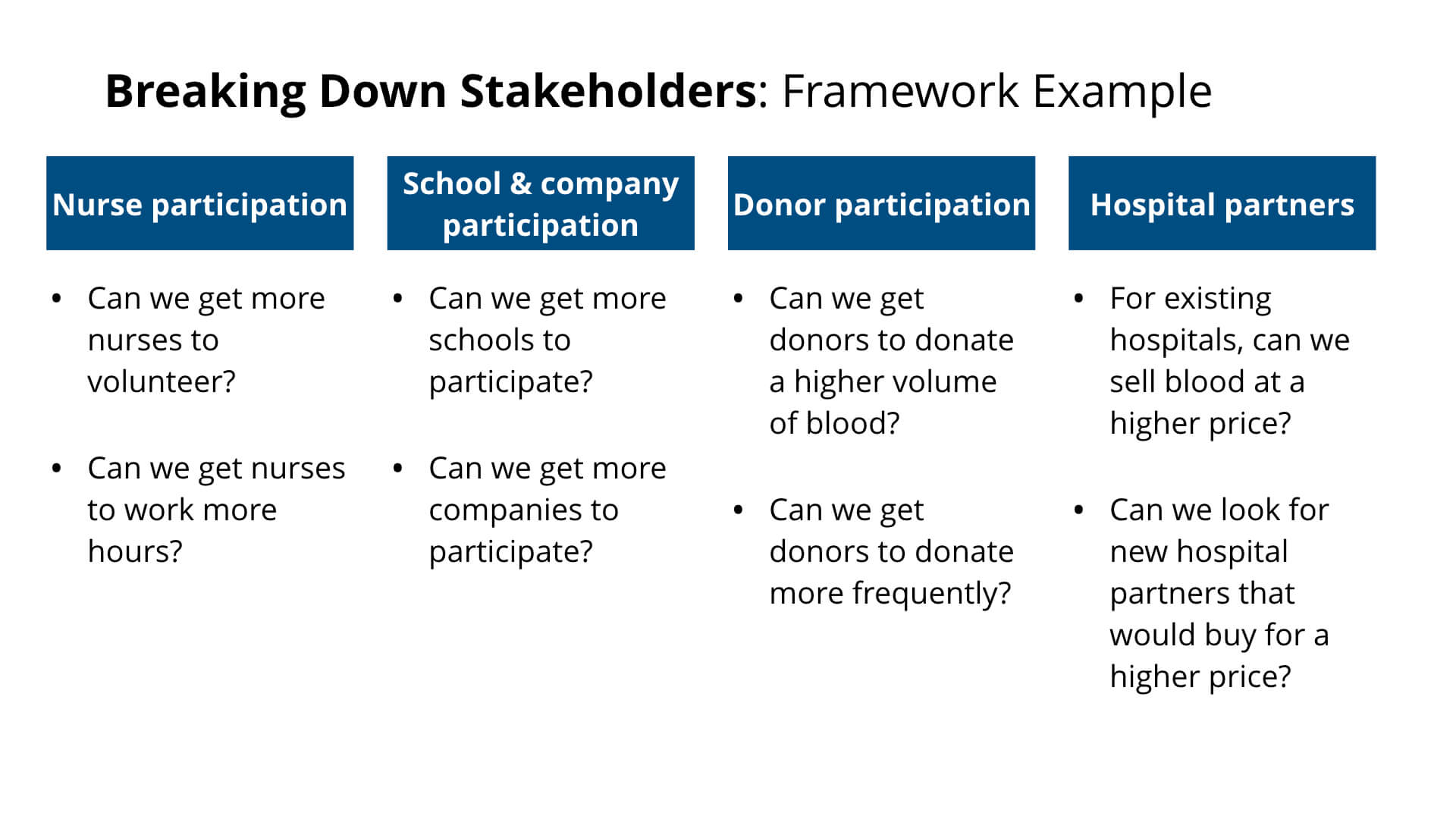
Strategy #4: Breaking Down Processes to make a Framework
Similar to the previous case framework strategy, some cases may require you to focus on improving or optimizing a particular process.
For these cases, the primary areas of your case framework will be each major step of the process.
Let’s take a look at an example: Your client is a waste disposal company that manages a fleet of drivers and garbage trucks that go to residential homes, collect garbage, and then dump the garbage in city landfills. They have an obligation to collect each home’s garbage once a week. Recently, they have been failing to meet this requirement and are backed up with garbage disposal requests. What is causing this issue and what should they do to fix it?
For cases involving processes and efficiencies, it can be helpful to look at the different components or steps in the process.
We can think about the process of collecting and disposing of garbage in the following steps:
- Get in a garbage truck
- Drive along a designated route
- Collect garbage at each stop
- Dispose of the garbage in the landfill
Using these steps as the primary areas of our framework, we can create the following case framework:

Once you have systematically listed all of the steps in a process, you can identify the pain points or bottlenecks that are causing the issue and determine ways to improve the process.
Strategy #5: Two-part MECE Frameworks
An easy way to make a 100% MECE framework is to use a two-part MECE framework. For the first step, start with a X and Not X framework. Some examples include:
- Internal / external
- Short-term / long-term
- Economic / non-economic
- Quantitative / qualitative
- Direct / indirect
- Supply-side / demand-side
- Upside / downside
- Benefits / cost
There are probably hundreds more frameworks that follow this pattern.
These frameworks are by definition 100% MECE. Since all of these frameworks are X or Not-X, they are mutually exclusive. There is no redundancy or overlap between X and Not-X.
Together, X and Not-X are also completely exhaustive. They cover the universe of all ideas and possibilities.
The X and Not-X framework by itself is good enough for a lot of the questions you could get asked in a case interview.
If you’re asked to brainstorm ways to decrease costs, you can create a framework consisting of decreasing variable costs and decreasing non-variable costs, also known as fixed costs.
If you’re asked to brainstorm barriers to entry, you can create a framework consisting of economic barriers to entry, such as cash and equipment, and non-economic barriers to entry, such as brand name or distribution channels.
However, to take your framework to the next level and truly impress your interviewer, we have the option of doing step two.
Step two involves adding another layer of X and Not X into your framework. What do we mean by this?
Let’s say you are trying to help a city decide whether they should host the upcoming summer Olympics. You start off with a framework consisting of benefits and costs. You can take this framework to the next level by adding another layer, such as adding in short-term and long-term.
With this additional layer, your framework now has four categories: short-term benefits, long-term benefits, short-term costs, and long-term costs. This is a 100% MECE framework that enables you to think through all possible considerations in deciding whether a city should host the Olympics.
Let’s look at another example. Suppose you are trying to figure out how to reduce a company’s costs. You start with a framework consisting of variable costs and fixed costs. You can take this framework to the next level by adding another layer, such as direct and indirect.
With this additional layer, your framework now has four categories: ways to directly reduce variable costs, ways to indirectly reduce variable costs, ways to directly reduce fixed costs, and ways to indirectly reduce fixed costs. This is another 100% MECE framework.
Case Frameworks: The 6 Most Common Frameworks
There are six common case frameworks in consulting case interviews.
Profitability frameworks are the most common types of frameworks you’ll likely use in consulting first round interviews.
A profitability case might look like this: “An electric car manufacturer has recently been experiencing a decline in profits. What should they do?”
There are two steps to solving a profitability case.
First, you need to understand quantitatively, what is the driver causing the decline in profits?
You should know the following basic profit formulas.

Is the decline in profitability due to a decline in revenue, an increase in costs, or both?
On the revenue side, what is causing the decline? Is it from a decrease in quantity of units sold? If so, is the decrease concentrated in a particular product line, geography, or customer segment?
Or is the decline due to a decrease in price? Are we selling products at a lower price? Is there a sales mix change? In other words, are we selling more low-priced products and fewer high-priced products?
On the cost side, what is causing the increase in costs? Is it from an increase in variable costs? If so, which cost elements have gone up?
Or is the increase in costs due to an increase in fixed costs? If so, which fixed costs have gone up?
Next, you need to understand qualitatively, what factors are driving the decline in profitability that you identified in the previous step.
Looking at customers, have customer needs or preferences changed? Have their purchasing habits or behaviors changed? Have their perceptions of the company changed?
Looking at competitors, have new players entered the market? Have existing competitors made any recent strategic moves? Are competitors also experiencing a decline in profitability?
Looking at the market, are there any market trends that we should be aware of? For example, are there new technology or regulatory changes? How do these trends impact profitability?
Putting all of this together, we get the following profitability framework.

Once you have gone through this profitability framework and understand both quantitatively what is causing the decline in profits and qualitatively why this is happening, you can begin brainstorming ideas to address the profitability issue.
Among the ideas that you brainstorm, you can prioritize which recommendations to focus on based on the level of impact and ease of implementation.
See the video below for an example of how to solve a profitability case using this profitability framework.
Market entry frameworks are the second most common types of frameworks you’ll likely use in consulting first round interviews.
A market entry case might look like this: “Coca-Cola is considering entering the beer market in the United States. Should they enter?”
To create a market entry framework, there are typically four statements that need to be true in order for you to recommend entering the market:
- The market is attractive
- Competition is weak
- The company has the capabilities to enter
- The company will be highly profitable from entering the market
These statements form the foundation of our market entry framework.

Note the logical order of the buckets in the framework.
We first want to determine whether the market is attractive. Then, we need to check if competition is weak and if there is an opportunity to capture meaningful market share.
If these two conditions are true, then we need to confirm that the company actually has the capabilities to enter the market.
Finally, even if the company has the capabilities to enter the market, we need to verify that they will be profitable from entering.
This is a logical progression that your market entry framework will take you through to develop a recommendation for market entry cases.
Merger and acquisition frameworks are also common frameworks you’ll use in consulting interviews.
There are two common business situations.
The first situation is a company looking to acquire another company in order to access a new market, access new customers, or to grow its revenues and profits.
Another situation is a private equity company looking to acquire a company as an investment. Their goal is to then grow the business using their operational expertise and then sell the company years later for a high return on investment. This type of case interview is called a private equity case interview .
In either of these situations, mergers and acquisition cases typically involve acquiring an attractive, successful company.
It is rare to get a case in which a company or private equity firm is looking to acquire a poorly performing company to purchase at a discount. Nevertheless, you can always clarify the goal of the merger or acquisition with the interviewer before beginning the case.
In order to recommend making an acquisition, four statements need to be true.
- The market that the acquisition target is in is attractive
- The acquisition target is an attractive company
- The acquisition generates meaningful synergies
- The acquisition target is at a great price and will generate high returns on investment
These statements become the basis of our merger and acquisition framework.

Synergies is an area that should absolutely be included in any merger or acquisition framework. A merger or acquisition can lead to revenue synergies and cost synergies.
Revenue synergies include:
- Having access to new customer segments
- Having access to new markets
- Having access to new distribution channels
- Cross-selling opportunities
- Up-selling opportunities
Cost synergies include:
- Eliminating cost redundancies
- Consolidating functions or groups
- Increasing buying power with suppliers, manufacturers, distributors, or retailers
Pricing frameworks are used in cases involving the pricing of a product or service. To develop a pricing framework, you should be familiar with the three different ways to price a product or service.
- Pricing based on costs : set a price by applying a profit margin on the total costs to produce or deliver the product or service
- Pricing based on competition : set a price based on what competitors are charging for products similar to yours
- Pricing based on value added : set a price by quantifying the benefits that the product provides customers
Your answer to pricing cases will likely involve a mix of all three of these pricing strategies.
Your pricing framework will look something like the following.

Pricing based on costs will determine the minimum price you can realistically set. Pricing based on value added will determine the maximum possible price. Pricing based on competition will determine which price in between these two price points you should set.
In order to get customers to purchase your product, the difference between your price point and the customer’s maximum willingness to pay must be greater than or equal to the difference between your competitor’s price point and the customer’s maximum willingness to pay for their product.
New product frameworks are used to help a company decide whether or not to launch a product or service.
New product frameworks share many similarities with market entry frameworks. In order to recommend launching a new product, the following statements would need to be true:
- The product targets an attractive market segment
- The product meets customer needs and is superior to competitor products
- The company has the capabilities to successfully launch the product
- Launching the product will be highly profitable
Expanding on these areas, your new product framework could look like the following:
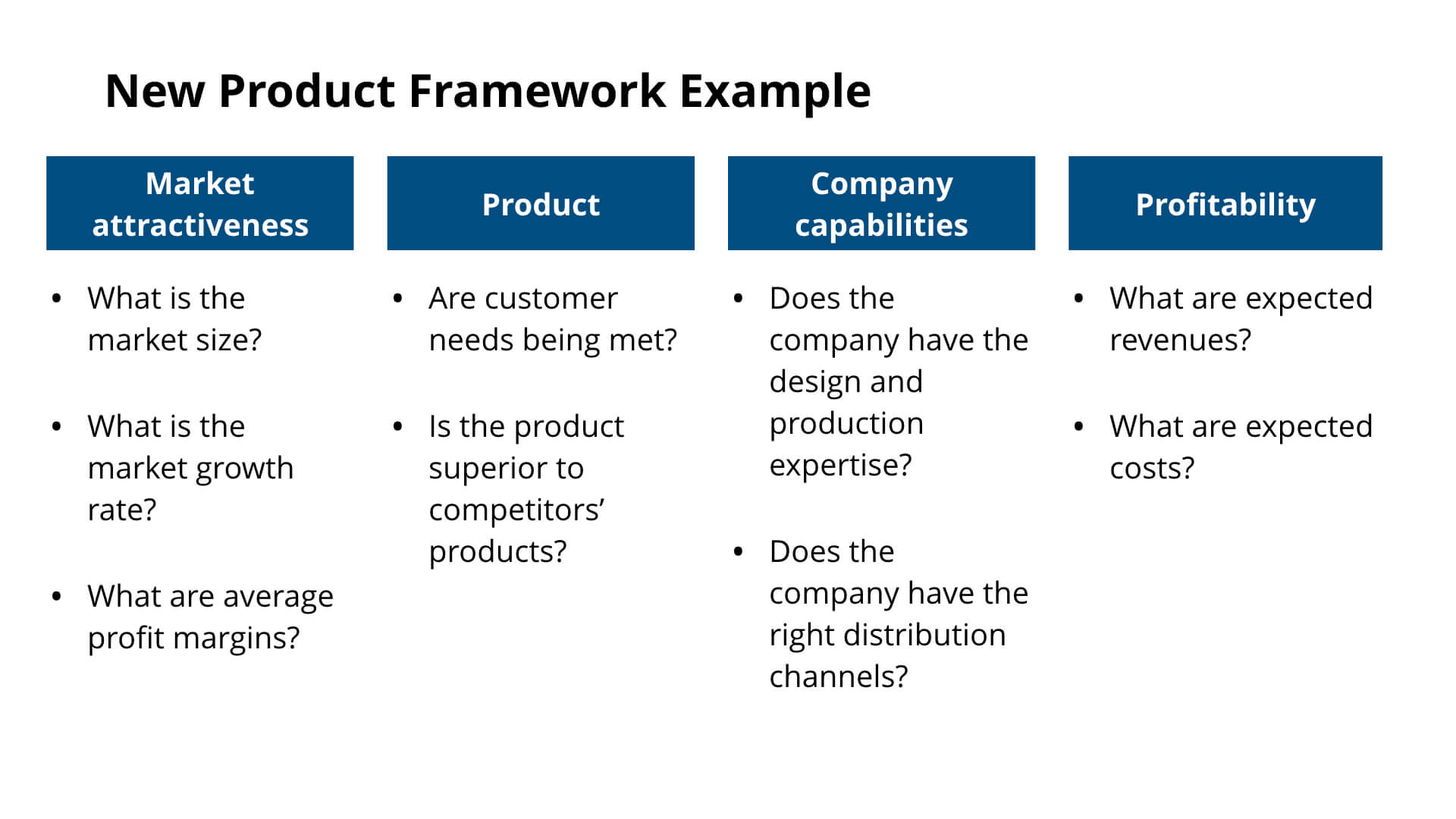
A comprehensive guide to market sizing questions and market sizing frameworks can be found in our comprehensive market sizing article. You can also watch the video below:
As a summary, market sizing or estimation questions ask you to determine the size of a particular market or to estimate a particular figure.
There are two different market sizing frameworks or approaches:
- Top-down approach : start with a large number and then refine and break down the number until you get your answer
- Bottom-up approach : start with a small number and then build up and increase the number until you get your answer
To create your market sizing framework, simply write out in bullet points, the exact steps you would take to calculate the requested market size or estimation figure.
Consulting Frameworks Every Consultant Knows
There are six consulting frameworks that nearly every consultant knows.
I would not recommend using these exact frameworks during a case interview because the interviewer may think you are just regurgitating memorized information instead of thinking critically about the case.
Instead use the four framework strategies that we covered earlier in this article to create tailored and unique frameworks for each case.
Nevertheless, it is helpful to review these common consulting frameworks in order to understand the fundamental concepts and business principles behind them.
Porter’s Five Forces framework was developed by Harvard Business School professor Michael Porter. This framework is used to analyze the attractiveness of a particular industry.
There are five forces that determine whether an industry is attractive or unattractive.

Competitive rivalry: How competitive is the industry?
The more competitive an industry is in terms of number and strength of competitors, the less attractive the industry is. The less competitive an industry is, the more attractive the industry is.
Supplier power: How much power do suppliers have?
Suppliers are companies that provide the raw materials for your company to produce goods or services. The fewer suppliers there are, the more bargaining power suppliers have in setting prices. The more suppliers there are, the weaker bargaining power suppliers have in setting prices.
Therefore, high supplier power makes the industry less attractive while low supplier power makes the industry more attractive.
Buyer power: How much power do buyers have?
Buyers are customers or companies that purchase your company’s product. The more buyers there are, the weaker bargaining power buyers have in setting prices. The fewer buyers there are, the more bargaining power buyers have in setting prices.
Therefore, high buyer power makes the industry less attractive while low buyer power makes the industry more attractive.
Threat of substitution: How difficult is it for customers to find and use substitutes over your product?
The availability of many substitutes makes the industry less attractive while a lack of substitutes makes the industry more attractive
Threat of new entry: How difficult is it for new players to enter the market?
If barriers to entry are high, then it is difficult for new players to enter the market and it is easier for existing players to maintain their market share.
If barriers to entry are low, then it is easy for new players to enter the market and more difficult for existing players to maintain their market share.
A low threat of new entrants makes the market more attractive while a high threat of new entrants makes the market less attractive.
A SWOT framework is used to assess a company’s strategic position. SWOT stands for strengths, weaknesses, opportunities, and threats.

Strengths : What does the company do well? What qualities separate them from competitors?
Weaknesses : What does the company do poorly? What are the things that competitors do better?
Opportunities : Where are the company’s opportunities for growth or improvement?
Threats : Who are the most threatening competitors? What are the major risks to the company’s business?
The 4 P’s framework is used to develop a marketing strategy for a product. The 4 P’s in this framework are: product, place, promotion, and price.

Product : If there are multiple products or different versions of a product, you will need to decide which product to market. To do this, you will need to fully understand the benefits and points of differentiation of each product.
Select the product that best fits customer needs for the customer segment you are focusing on.
Place : You will need to decide where the product will be sold to customers. Different customer segments have different purchasing habits and behaviors. Therefore, some distribution channels will be more effective than others.
Should the product be sold directly to the customer online? Should the product be sold in the company’s stores? Should the product be sold through retail partners instead?
Promotion : You will need to decide how to spread information about the product to customers. Different customer segments have different media consumption habits and preferences. Therefore, some promotional strategies will be more effective than others.
Promotional techniques and strategies include advertising, social media marketing, email marketing, search engine marketing, video marketing, and public relations. Select the strategies and techniques that will be the most effective.
Price : You will need to decide how to price the product. Pricing is important because it determines the profits and the quantity of units sold. Pricing can also communicate information on the quality or value of the product.
If you price the product too high, you may be pricing the product above your customer segment’s willingness to pay. This would lead to lost sales.
If you price the product too low, you may be losing potential profit from customers who were willing to pay a higher price. You may also be losing profits from customers who perceive the product as low-quality due to a low price point.
In deciding on a price, you can consider the costs to produce the product, the prices of other similar products, and the value that you are providing to customers.
The 3 C’s framework is used to develop a business strategy for a company. 3 C’s stands for customers, competition, and company.
The business situation framework was developed by a former McKinsey consultant, Victor Cheng, who added a fourth component to this framework, product.
Both of these frameworks are used to develop a business strategy for a company in a variety of situations, such as market entry, new product launch, and acquisition.

There is another similar framework called the 4C framework that expands upon the 3 C's. The 4C framework stands for customer, competition, capabilities, and cost.
The BCG 2x2 Matrix Framework was developed by BCG founder Bruce Hendersen. It is used to examine all of the different businesses of a company to determine which businesses the company should invest in and focus on.
The BCG 2x2 Matrix has two different dimensions:
- Market growth : How quickly is the market growing?
- Relative market share : How much market share does the company have compared to competitors?
Each business of the company can be assessed on these two dimensions on a scale of low to high. This is what creates the 2x2 Matrix because it creates four different quadrants.
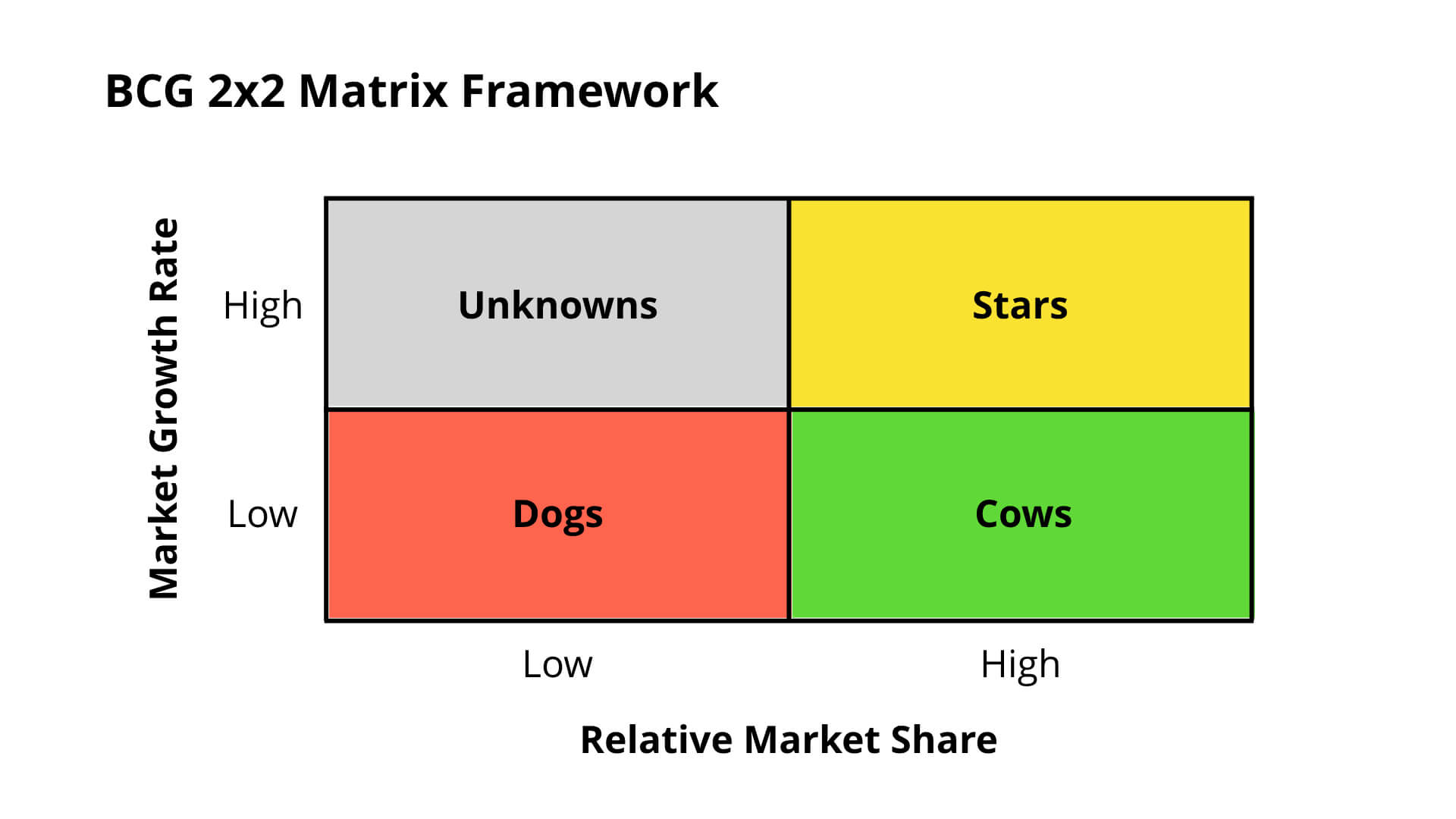
Each quadrant has a recommended strategy.
- Stars : These are businesses that have high market growth rate and high relative market share. These businesses should be heavily invested in so they can continue to grow.
- Cows : These are businesses that have low market growth rate, but high relative market share. These businesses should be maintained since they are stable, profitable businesses.
- Dogs : These are businesses that have low market growth rate and low relative market share. These businesses should not be invested in and should possibly even be divested to free up cash for other businesses.
- Unknown : These are businesses that have high market growth rate and low relative market share. The strategy for these businesses is not clear. With enough investment, these businesses could become stars. However, these businesses could also become dogs if the market growth slows or declines.
The McKinsey 7S Framework was developed by two former McKinsey consultants, Tom Peters and Robert Waterman. The 7S Framework identifies seven elements that a company needs to align on in order to be successful.

These elements are:
- Strategy : The company’s plan to grow and outcompete competitors
- Structure : The organization of the company
- Systems : The company’s daily activities and processes
- Shared values : The core beliefs, values, or mission of the company
- Style : The style of leadership or management used
- Staff : The employees that are hired
- Skills : The capabilities of the company’s employees
Land your Dream Consulting Job
Here are the resources we recommend to land your dream consulting job:
For help landing consulting interviews
- Resume Review & Editing : Transform your resume into one that will get you multiple consulting interviews
For help passing case interviews
- Comprehensive Case Interview Course (our #1 recommendation): The only resource you need. Whether you have no business background, rusty math skills, or are short on time, this step-by-step course will transform you into a top 1% caser that lands multiple consulting offers.
- Case Interview Coaching : Personalized, one-on-one coaching with a former Bain interviewer.
- Hacking the Case Interview Book (available on Amazon): Perfect for beginners that are short on time. Transform yourself from a stressed-out case interview newbie to a confident intermediate in under a week. Some readers finish this book in a day and can already tackle tough cases.
- The Ultimate Case Interview Workbook (available on Amazon): Perfect for intermediates struggling with frameworks, case math, or generating business insights. No need to find a case partner – these drills, practice problems, and full-length cases can all be done by yourself.
For help passing consulting behavioral & fit interviews
- Behavioral & Fit Interview Course : Be prepared for 98% of behavioral and fit questions in just a few hours. We'll teach you exactly how to draft answers that will impress your interviewer.
Land Multiple Consulting Offers
Complete, step-by-step case interview course. 30,000+ happy customers.
Use Our Resources and Tools to Get Started With Your Preparation!
Market entry, market entry could be a possible solution that may not be obvious at the beginning of a case, market entry problems have two variations, according to the ansoff matrix.
- Introduction of an existing product in a new market (market development)ge.com/en/case-interview
- Introduction of a new product in a new market (diversification)
As you know from the Ansoff Matrix , usually growth questions require a market entry strategy for the case interview solution. “Our business model is currently stagnating. What should we do?”
Use the following five steps to approach a market entry case
1. Paraphrase and clarify the objective at the beginning (same as all other cases)
As usual, take good notes! Start with paraphrasing the problem and clarify all questions to make sure you understand the problem. Take a minute to structure your thoughts and decide the questions you want to ask based on the structure. In short, in order to have a market entry strategy, you need to:
- Understand the company and its current market, and also the new market the company wants to enter.
- Evaluate the financial aspects.
- Evaluate the economic implications of entering the market. If it makes sense, decide how: Through organic (independently) or inorganic (inter-dependently)? If inorganic, then would it be through a Joint Venture or M&A?
Frameworks such as Porter's Five Forces can help you structure thoughts and systematically uncover key information. But, in an interview, avoid saying that you are using Porter's Five Forces or any other standard framework as you run the risk of portraying yourself as force-fitting a framework.
2. Understand the client's company
Understand why the client wants to enter the new market and identify the key issue. Knowing this piece of information will be important in making the final recommendation.
Other important information:
- What are current revenue streams?
- What are the client's key strengths and weaknesses? ( SWOT )
- What is the product mix? How many and what types of product lines, brands, variations of products does the company have? What is the lifecycle of each product? Also, how closely related are the current products?
- Who are current customers, and how are they segmented?
- What are the current distribution channels?
- What is the client's current financial situation ?
3. Understand the market of interest
Understand the market the client wants to enter and evaluate its attractiveness. Start by estimating the market size if that information is available (it is implied that you would first need to estimate market size in such cases).
- What is its growth rate ?
- At what stage of the lifecycle is it? Emerging, Mature, Declining?
- What are the customer segments, and what are their respective needs?
- Is there a key technology involved? If so, how quickly is it likely to change?
- What are current trends in the industry?
- Who are the key players in the market? What is their market share? What are their differentiating factors?
- What is their response to the determined key trends?
- Are there substitute products?
4. Evaluate the financial aspects
Key questions:
- Costs: What are barriers to market entry (i.e. investment costs)?
- Costs: What are expected fixed and variable costs?
- Revenues: What is the expected price of the product for and how many units are expected to be sold?
- After how many years will the client break-even and what is the rate of return ( understand that money has a different value over time )?
5. Evaluate the economic implications of entering the market
Remember you do not need to investigate all these questions, but you do need to evaluate and understand what questions are important by considering the reasons the client wants to enter the market.
If you decide that entering a new market is a good idea, it would make sense to recommend to the client how to do it .
Entering a new market can be generally done in three key ways:
- Start from scratch
- Through a Joint Venture
- Through M&A
Based on the data, if you decide that the venture is not a good idea, recommend an alternative plan (product differentiation, cost-cutting, international presence, etc.). Since you now know the company structure, the “old” and the "new" market, make sure to structure your recommendation.
- Competitive advantage : Can you apply the same business strategy as in your current market, or do you have to adapt the product, marketing, or even sales channels to reach customers?
- Timing: Can you lever a first-mover advantage, or would you rather let the competitors try their luck first?
- Speed of entry: Define whether you want to test a single store or region, or whether you want to cover the entire market at once.
- Entry mode: How much commitment are you looking at? Would it be a simple export strategy, where you can exit easily but have less control, OR a wholly owned subsidy, where investment costs are high, but you also have more control?
- The organizational structure of the new branch: Do you want to decide centrally or leave lots of freedom to the individual manager of the country?
Once you have all your answers, synthesize them to give a recommendation based on the facts you collected. Don't forget to take another minute to structure your answer but make sure to provide your answer first and then the reasons! Check out our article about the pyramid principle for more details regarding communication.
Key takeaways
- Market entry cases are often hidden in other case types, such as cases involving increasing revenues of a company.
- Look for the most critical success factors for the client.
- When developing a market entry strategy, focus on how the new market fulfills the success factors sought by the client.
- Make sure to lay out several different market entry strategies and evaluate those against each other.
Questions on This Article
Cost revenue and entry strategy, why assessing 2. company financials prior to 3. targeted market/customer interest, market entry case with multiple choices, related cases.

RWE Consulting Case: Floating Wind in Japan

EY-Parthenon Case: Nachhaltiges Geschäftsmodell

OC&C Strategy Consultants Case: Expansion einer Schmuck Agentur in China

CTcon Case: Das beste Eis der Stadt!

tkMC Case: Portfolio expansion in the material trade business

- Select category
- General Feedback
- Case Interview Preparation
- Technical Problems
What is a market entry case?
Introduction | Case types | Sample framework | Example case Market entry cases ask a candidate to evaluate a specific growth opportunity and decide whether or not the company should pursue it. 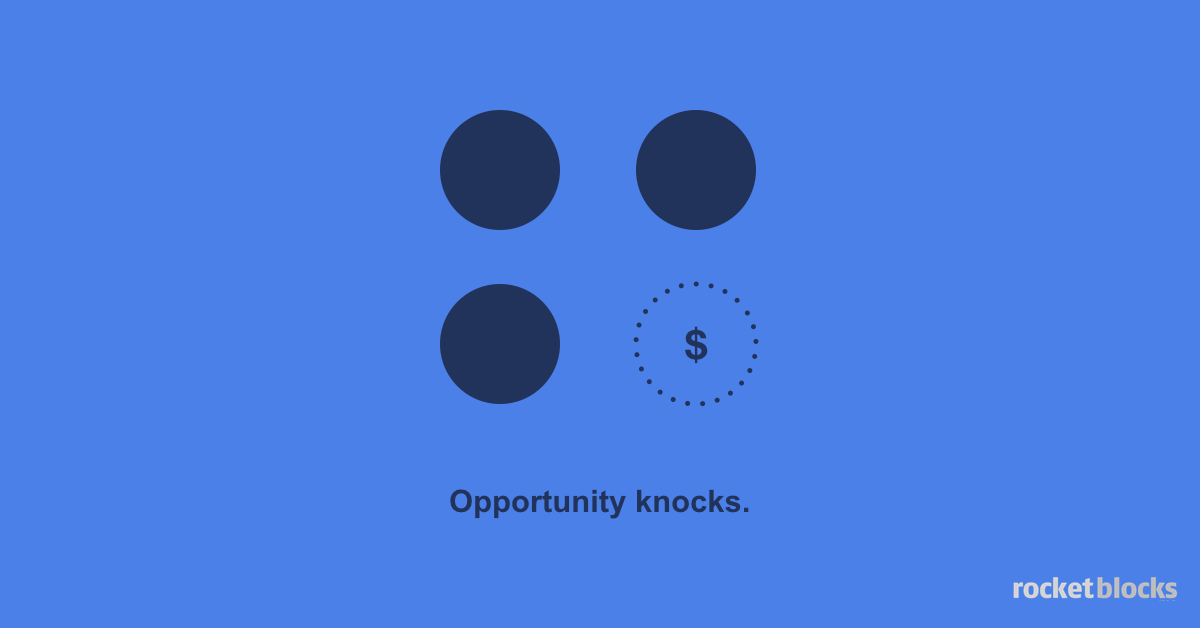 Introduction to market entry cases (Top)For example, a classic market entry case might read like this: “Retail Co. specializes in outdoor apparel for children. They’ve been very successful in the midwest and are considering launching in Canada due to similar climate and demographics. What factors would you look at to determine if this expansion would be successful?” Just hearing this type of question makes some people nervous - where do you start and how do you evaluate the problem in a structured way? Don’t worry; after reading this post, you’ll be able to recognize a market entry question like this and crack it in no time! Market entry cases are a very common type of case during the interview process. There are two reasons for this. First, they test a variety of skills consultants care deeply about: structured problem solving, logical reasoning and creativity. Second, consulting companies frequently help clients with market entry problems, and case interviews mirror real world consulting work. Since consultants often give candidates cases they’ve worked on with real clients, tso there’s a good chance you’ll get one of these eventually. The good news is, these are fairly straightforward cases. We’ll go through one framework that can be used to solve these types of cases, as well as a more detailed example. As always, don’t forget that every problem is unique, and a great answer will always take into account the nuance of the problem and propose a tailored framework. Types of market entry cases (Top)There are three main buckets of market entry cases: geographical, product line expansion, and generic growth strategy. 1. Geographic expansion casesThe question you’re trying to answer in the geographical type is whether a company should expand their current business to a new market. For example, if Chipotle should expand into Europe, or if Uber should launch in China. 2. Product line expansion casesIn the product portfolio type of market entry case, the question is if a company should launch a new product into their existing market. For example, if Harley Davidson should launch an electric motorcycle, or if Whole Foods should start selling meal kits in addition to groceries. 3. Generic growth strategy casesSometimes market entry cases can be hidden in the introduction but appear partway through the case. For example, your interviewer might say something akin to: “Client Co. has seen declining revenue recently. What should they do?” This is a growth strategy case, which could have various paths such as acquire a competitor or invest in internal R&D. One hypothesis may be expanding to a new market to grow their customer base. In this example, the market entry aspect of the case would branch out from a higher-level growth strategy problem. Market entry case framework (Top)Now that you’ve seen what market entry cases look like, let’s talk about how to solve them. There are four steps to these cases: assessing the target market, evaluating the company’s capabilities, quantifying the opportunity, and outlining a go-to-market strategy. Assessing the target marketIn this step, you’ll want to evaluate the market in question. The main goal here is to determine if the market is large, growing, and what the competitive landscape looks like. In addition, you’ll want to determine if there are any additional factors that might prevent a company from expanding successfully, for example, if there were a war in the country, high levels of corruption or anti-American sentiment. Key questions include:
Evaluating company capabilitiesNow it’s time to look internally, you’ll want to dive into the client’s business to understand their product offering, their current customers, strengths and weaknesses, and their financial situation. Just because a new market is attractive doesn’t mean a company should always expand there. The company needs to have the right characteristics to successfully enter. For example, expanding into China might look like a good opportunity for a hotel chain, but if they don’t have anyone on their team with experience in China and have never grown internationally before, it will probably be a very tricky strategy to carry out successfully. The key questions you’ll want to answer in this step are:
Quantifying the opportunityIf you’ve gone through the first two steps and decided the market entry is a good idea for the client, the next step is determining the investment that would be required to enter the market versus the expected revenue potential. In other words, would the juice be worth the squeeze?
Developing a go-to-market planThe final step for a market entry case is laying out the ‘how’ once you’ve come up with an answer on whether or not to enter. There are several ways a company could enter a new market. Each of these would be evaluated using pros and cons:
💡 Shameless plug: Our consulting interview prep can help build your skills Example market entry case (Top)Let’s try going through a market entry case using the framework above. The question we’ve been given is: “Taco Bell recently expanded into the UK with great success, should they launch in France as well?” We’ll walk through each question below and demonstrate the kind of thought process the candidate should be going through (and voicing over to the interviewer) if they were in a real case interview. Remember, this isn’t how an actual conversation would go, but it does provide an example of how this framework could be applied to a real question, and the types of issues you should be thinking about. Step 1: Assess the marketWe’ll begin by assessing the attractiveness of the French market. Let’s go through our key questions: How big is the market and is it growing? Here, we’d want to know how big the fast food market is in France and what the growth rate is. Let’s say our interviewer tells us it’s a $50B market and has been growing at 12% for the past 3 years. Right away, we see that this is a large and rapidly growing market, which means this is an attractive place to be at a high level. Who is the target customer and what are their needs or preferences? Based on what we know about Taco Bell domestically, we can build a profile of the target customer: someone who goes to other fast food restaurants, is looking for a quick and cheap meal, enjoys Mexican food, and isn’t very health conscious. The biggest question is if this type of consumer is as prevalent in France as they are in the US. We might receive additional information from our interviewer that the French don’t prefer spicy food and aren’t as familiar with Mexican cuisine. What is the competitive landscape? Competitors to Taco Bell would include any other businesses that meet the same customer needs mentioned above. For example, other fast food restaurants or other Mexican restaurant chains that are popular in France. In this case, we’re told there are no direct competitors (no Mexican fast food restaurants) but McDonalds, Subway, and Pizza Hut have ~25% of the fast food market. Are there any social, macroeconomic, or geopolitical factors to consider? Here we could bring in any current events that might impact our strategy. For example, we might know that the minimum wage in France is much higher than the US. This higher cost of labor could cut into Taco Bell’s profits if they weren’t able to raise prices to offset it. Overall, after a quick evaluation of the market, it appears to be an attractive region for a fast food restaurant, but there’s an open question on the customer preferences piece and whether French people will embrace Mexican food. Step 2: evaluating company capabilitiesThe next step is looking at Taco Bell’s current performance and determining if they would be successful expanding into France: What is the current product and customer mix? Taco Bell serves lunch and dinner with a broad menu of American Mexicanized food. Historically, their largest customer segment is 18-25 year old men, although menu additions such as salad bowls have aided in their effort to attract 25-35 year olds as well as women. Domestically, the bulk of their business comes from drive-thru orders, however, in the UK their urban locations attracted a broader demographic, including teens and families. What are the strengths and weaknesses of the company? Taco Bell is a well known brand that’s recognized globally. They’ve recently proved an ability to successfully co-brand menu items (for example their domestic partnership with Doritos) which could be employed abroad with popular brands in the target country. In addition, their success in the UK has shown they have the skills and experience needed to launch in a new market. What is the current financial position? Taco Bell’s revenue is ~$11B and has been growing in the double digits recently. We would also want to look at same store sales to determine if revenue was growing solely due to expansion or if existing locations were also seeing an increase in business. From this quick look, we see that Taco Bell is in a solid place financially and has a dominant position in the market. They’re experienced with new market entry as well. Step 3: quantifying the opportunityNow we want to determine if expanding into France will be financially attractive for Taco Bell. What share of the market could be captured? Of the $50B fast food market, how much do we think Taco Bell can capture? At this stage, we would likely be given some additional information, such as the market share of the largest competitors. We find out McDonalds has a 10% market share and they’ve had to transform their product in order to be successful - focusing on a Cafe area and larger seating spaces. In this case, we might assume Taco Bell could eventually capture just 1% of the French fast food market, or $500M, as the cuisine isn’t nearly as popular What would the main costs of entry be? The primary costs would include real estate, building the team, and doing market research to develop a menu tailored to local tastes. Marketing would also be a large cost to educate the French market about their brand and product. What are the outstanding risks? The biggest risk for Taco Bell is there’s no product-market fit e.g. the French consumer doesn’t eat Mexican food. One way to mitigate this is to start with a very small footprint, just a couple locations, and put them in a densely populated area with a more diverse population. Step 4: Developing a go-to-market planFinally, we would want to recommend a strategy for Taco Bell to enter France. In this case, growing organically makes the most sense as the brand is the major strength. Starting with a couple locations in Paris where there is lots of foot traffic and both locals and tourists makes sense. Additional market research would need to be done to determine which menu items should remain and what should be added to localize the flavor profiles. You’re bound to get a market entry case during the interview process, so it’s a good idea to get familiar with this framework and the types of questions you’ll be looking to answer. Your interviewer will guide you through the process a bit in terms of the additional information they start to share, so you’ll see where to push more or less. Remember, these are real problems clients are looking for advice on, so it’s great practice in that regard as well! Read this next:
See all RocketBlocks posts . Get interview insights in your inbox:New mock interviews, mini-lessons, and career tactics. 1x per week. Written by the Experts of RocketBlocks. P.S. Are you preparing for consulting interviews?Real interview drills. Sample answers from ex-McKinsey, BCG and Bain consultants. Plus technique overviews and premium 1-on-1 Expert coaching. Launch your career.
Free resources
Interview prep
Resume advice
Beating the odds in market entryThe annals of business history report that for every successful market entry, about four fail. Inexperienced start-ups suffer some of these disappointments, but so do many sophisticated corporations and seasoned entrepreneurs who should know better. After all, industrial economists and strategists generally agree about what makes market entrants successful: factors such as timing, scale relative to the competition, and the ability to leverage complementary assets. Moreover, the magnitude and importance of entry decisions—encompassing everything from geographic expansion to new products to diversification efforts—should prompt detailed analysis. But cognitive biases —systematic errors in the way executives process information—often wreak havoc on market entry decisions. 1 1. Behavioral economists have written extensively about the impact of cognitive biases on financial markets and on a wide range of decisions. See Charles Roxburgh, “ Hidden flaws in strategy ,” McKinsey Quarterly , 2003 Number 2, pp. 26–39 for an overview of the relationship between cognitive biases and strategic mistakes, as well as a partial summary of the broader literature on this topic. For one thing, when confronted with a difficult decision, most executives rely solely on an inside view: they focus excessively on the specific case at hand. This tendency prevents many of them from developing an outside perspective based on previous market entries and even from evaluating opportunities in the light of common predictors of success. Furthermore, when an analysis is conducted, cognitive biases often lead executives to believe that a company's skills are more relevant than they really are, that the potential market is bigger than it actually is, or that rivals won't respond to the entry move. The costs of miscalculation can be large. The efforts of Anheuser-Busch to diversify into the snack food business, for example, went awry when the beer giant underestimated Frito-Lay's response to a threat to its Doritos franchise. Similarly, EMI failed to capitalize successfully on an exciting medical innovation—the CAT scanner—because the company overestimated its ability to compete in this new market and underestimated the strengths of experienced competitors such as General Electric and Siemens. Fortunately, some practical steps can help executives control cognitive biases in market entry decisions. Objective predictors of success, for example, can be used to create a reference class: a group of similar decisions that other companies have made in the past. 2 2. For a description of how reference classes can inform decisions extending beyond market entry, see Dan Lovallo and Daniel Kahneman, “Delusions of success: How optimism undermines executives' decisions,” Harvard Business Review , July 2003, Volume 81, Number 7, pp. 57–63. The reference class yields comparative data that are an invaluable reality check on the inside-view analysis. (Government bodies in the United Kingdom have used reference class forecasting to predict the cost of infrastructure projects, and the American Planning Association, a society of professionals focused on public-works projects, has endorsed the use of reference classes.) Additional tools, which can improve the quality of the inside view itself, include competitive-gaming exercises, the study of industry life cycles, and a policy of involving managers from diverse parts of the organization in important decisions. In our experience, the combination of a robust outside view and an improved inside one—better assessments of value propositions, capabilities, market size, competitors, market share and revenue, and costs—dramatically raises the odds of making good entry decisions. Step outsideCompanies have no reason to repeat the mistakes of others. Yet they frequently fail to learn from history, because a myopic focus on the market entry decision at hand prevents them from creating a reference class of at least five (and preferably more) similar entry decisions in the past. Such a reference class promotes systematic learning from the successes and failures of other companies. It also counteracts the tendency of many decision makers to fall into the “confirmation trap” : seeking information that confirms their hypotheses. A broad reference class, in other words, forces analysts to consider more possibilities and new data. The failure rate of projects is high in industries such as pharmaceuticals, oil and gas, and motion pictures. Companies in these sectors do understand how important it is to play the probabilities and can draw on a rich body of cases in creating a reference class. But companies that place product bets less frequently, and with less apparent risk, have fewer internal reference cases to compare and generally either don't consider looking at the experience of outside companies and industries or, if they do, often conclude that the effort isn't worth the expense. Since the tens (if not hundreds) of millions of dollars at stake in a typical big-company market entry far outweigh the costs of forming a reference class, that conclusion is penny wise and pound foolish. Companies developing an outside view can benefit from a wide body of statistical research showing that six factors are particularly important predictors of successful market entry (Exhibit 1). Even before companies select their reference cases, an explicit review of these factors sometimes shows that the dice are loaded against going forward. In constructing a reference class, the first step is to review which of these factors are most relevant. Say a small, technologically adroit company that lacks complementary assets enters a new industry at the same time as large, diversified companies that do have them enter it. In this case, the small company should create a reference class of similar entrants in other industries, not this one. Next, companies should look for reference cases involving as many of the most important factors as possible (Exhibit 2). It's important to uncover both successful and, even more, failed entries so that the reference class approximates the distribution of actual outcomes. The greater the overlap with the experience of the industry in question, the more valuable each example will be for the reference class. But it is also useful—and sometimes, if the industry is a new or emerging one, necessary—to reach out across different industries. The use of a reference class guards against a weak and dangerous alternative: hypotheses based on an analysis of just one or two cases, whose selection is subject to the “availability bias”: choosing whatever comes to mind most readily. During the buildup to the current conflict in Iraq, for example, the two analogies consistently reported in the press were the Vietnam War and the 1991 Gulf War. These were natural choices, since they were the two most recent large-scale conflicts involving the United States, but they weren't necessarily the most similar ones. Expanding the reference class to include the troubles in Northern Ireland, Britain's involvement in the Middle East after World War I, and US policy in Europe after World War II might have raised fresh, relevant questions about troop requirements, the policing of occupied populations, and postwar reconstruction. Improve the inside viewBesides developing a reference class, companies should remove any bias from their analysis of the entry decision. Start by targeting five core issues: the value proposition and capabilities, the market's size, the competition, market share and revenue, and costs (Exhibit 3). Of course, other analyses (of regulatory issues, for example) are occasionally necessary and sometimes of paramount importance. What value proposition and skills are necessary?The closer a company stays to its core capabilities and value proposition, the greater its chances of mounting a successful entry. 3 3. Companies should measure the distance in “degrees.” Selling the same product through the same distribution channel to the same customer groups, but in a new geography, represents one degree of difference. Selling to different customer groups as well adds a second degree. But companies can be egocentric: they may assume, for example, that since their employees are excited about a product customers will feel the same way, that the resources and assets they already have are the ones needed to meet the needs of the target market, that what they do well is sufficient for success in it, or that they can easily acquire any missing skills. All of these biases undermine the analysis. A memorable example of a company that underestimated the difficulty of developing new skills dates back to the 1970s, when the music producer EMI entered the CAT scanner business on the back of an innovation developed primarily by Godfrey N. Hounsfield, a researcher in the company's labs. EMI had no experience in the manufacture of medical-diagnostic-imaging equipment or in medical sales and distribution. Its senior management decided to build these capabilities rather than partner with other companies to obtain them. More than five years passed before EMI delivered the first product. Soon thereafter, General Electric, with its world-class manufacturing and sales and distribution networks (and 75 years of experience with X-ray equipment), entered the US market. So did Siemens, which had already entered the European one. Not surprisingly, GE and Siemens became dominant and EMI exited after sustaining substantial losses. (Hounsfield, however, won a Nobel Prize in 1979.) To avoid such mistakes, companies should use the reference class to identify the key determinants of successful entries into similar markets. Which product attributes and business models have succeeded in the past? Were the winners superior marketers? Did they have outstanding distribution systems? If new capabilities seem to be needed for success, companies should exercise caution and consider contractual approaches, such as joint ventures and licensing, that can help them secure the missing assets. It's frequently valuable to have people who are not directly involved in making the decision help determine what's needed for a successful entry. After all, the analysis of managers from different divisions will be less biased by ingrained knowledge of the organization's current value proposition and skills. How big is the market?Estimating a market's potential size typically involves categorizing customers into a number of segments and then using pricing and elasticity assumptions to estimate the percentage of buyers in each category the company might capture. Two biases typically distort such estimates. One is the fact that human beings, when considering potentially positive outcomes, are almost always optimistic. The second is “anchoring and adjustment”: the failure to adjust estimates sufficiently from an initial value, regardless of its origin. An optimistic anchor that often infects market estimates is an industry's current growth rate, which rarely endures for long. Another anchor is the initial “gut” forecast number an analyst plugs into a spreadsheet with the intention of making adjustments as more information arrives. How influential are such anchors? In one recent study, experienced real-estate brokers, who had contended that the listing price 4 4. The price a person selling a house asks for it publicly. of a house wouldn't affect their evaluation of its “true” value, were asked to assess a property. Each broker received a ten-page booklet on the house and on the prices and characteristics of houses in the area. Each then visited it, plus others in the neighborhood. The agents didn't know that the listing prices they had been given for the house in question were all different and had been randomly manipulated within a range of plus or minus 11 percent of the actual listing price. Those spurious listing prices significantly affected the evaluations of the agents. Yet even when they were told about the results, they maintained that the listing-price anchor had had no effect on them. To avoid anchoring estimates on a target market's current growth rate, companies should always try to determine the life cycle stage of the business they wish to enter. At some point, most industries experience shakeouts, which can be particularly severe in fast-growing sectors. Although it is difficult to predict the exact timing, efforts to think through the possibility of a shakeout—and how many companies are likely to survive it—often highlight the unsustainability of current growth rates. A second useful way of improving estimates of market size is to use the reference class of other entrants as a benchmark. Consider the fate of the Segway, a new type of two-wheeled vehicle unveiled in December 2001. Although we don't know for sure what the inventor, Dean Kamen, did to estimate the size of the market, we do know how many Segways he thought could be sold after a year: 10,000 a week. A typical approach for arriving at such a figure would have involved combining an analysis of the number of consumers who could both afford the Segway and realistically use it for commuting or recreation, on the one hand, with penetration rates in this demographic for similar products, such as scooters and bicycles, on the other. But the Segway's usefulness depended on changes to infrastructure. How many cities would allow people to drive the vehicle on sidewalks? If roads were the only alternative, how many potential purchasers would still be willing to use it? Since the answer to both questions was “not many,” just 6,000 Segways were sold in the first 21 months. A broader reference class that included conventional automobiles, fuel cell cars, hydrogen cars, and infrastructure-dependent technologies such as high-definition television and telephones might have shown that securing the right to ride the Segway in cities was of paramount importance. After all, it took years to create the roads, power grids, standards, and networks necessary for cars, electric lighting, HDTV, and telephone service to become ubiquitous. Who are the potential competitors?Other market entries fail because companies underestimate the competition. Many decision makers, for example, don't grasp the likelihood that their rivals may enter the same market they have targeted; they suffer from competitive blind spots when thinking about what could go wrong. That's what happened to British Satellite Broadcasting (BSB) after it outbid Rupert Murdoch's Sky Television, in 1988, to win the contract to broadcast on a new British satellite. Even as BSB prepared to launch its service, Murdoch obtained the rights to broadcast from a Spanish satellite that could reach Great Britain. Sky went on the air in early 1989, beating BSB to the market by 13 months. Despite Murdoch's 1988 bid, Richard Brooke, BSB's treasurer, said that “Murdoch’s announcement came from left field and took everybody by surprise.” While it is difficult to generate a reference class for potential entrants, in our experience it can be very helpful to brainstorm about them and then to test these hypotheses in a disciplined way. The first companies to consider are those in the same industry; after all, if one of them is contemplating plunging into a market, its competitors probably are too. If companies in other industries could succeed in the target market, they should be considered as well. Hindsight will always reveal the “necessary” capabilities, but expanding the list of possible competitors increases the odds of spotting unexpected threats. Although discretion is sometimes the better part of valor, this analysis is meant to help companies react to the competition's moves before they happen, not to scare entrants away from a fight. The benefits of recognizing and countering potential entrants can be large. Consider the case of Softsoap, the first liquid-soap manufacturer. The shift from hard to liquid soap was an incremental innovation that couldn't be protected by a patent; there are too many ways to make the product. The businessman who had the idea for Softsoap, Robert Taylor, knew that if it entered the industry without protection, consumer-marketing giants like Dial would crush it. His solution: signing contracts to obtain all of the existing capacity for the pumps capable of dispensing Softsoap. The result was an 18-month lead on the competition. Today, Softsoap is synonymous with the product category in the same way Coke is with cola drinks. What market share and revenue can be achieved?In addition to overlooking potential competitors, companies often fail to factor in the likely responses of current ones. We call this the “brick wall effect”: assuming that competitors won't adjust their prices, broaden their product offerings, or otherwise change strategy in response to the entry. (The focus on current competitors rather than potential new ones distinguishes the brick wall effect from the competitive blind spots described previously.) Consider the experience of Anheuser-Busch after it diversified into snack foods, in 1979. Its Eagle Brand operation initially succeeded by staying small and focusing on supplying airlines and taverns. Once Anheuser-Busch expanded beyond these markets, however, it was encroaching on Frito-Lay's turf, stimulating a harsh counterattack: deep across-the-board price cuts by Frito-Lay and a concerted effort to drive Eagle out of supermarkets. These aggressive moves ultimately forced Anheuser-Busch to sell Eagle to P&G. The best way to anticipate competitive responses is to conduct gaming exercises, with executives role-playing competitors to gain insight into their likely behavior. One telecommunications company that leaned toward using a premium-feature, low-cost strategy to enter a new market assumed that the incumbents would maintain the status quo of premium features and high prices. But after using game theory, simulations, and competitive analysis to assess the incumbents' likely responses, the prospective entrant realized that it had overestimated its returns by a hefty 800 percent. It modified its entry strategy and performance expectations accordingly. 5 5. Hugh Courtney, 20/20 Foresight: Crafting Strategy in an Uncertain World , Boston: Harvard Business School Press, 2001, pp. 167–71. Using the reference class to set reasonable bounds on market share estimates also helps. If the reference class attained only a 3 to 5 percent market share, decision makers should pause when they see higher estimates. How much will it cost?Good cost estimates can make the difference between creating value and destroying it, but many companies can't arrive at them, because of the “planning fallacy”: the tendency to underestimate the duration and cost of any endeavor. Most of us recognize this problem in our own lives, and research shows that we should. One study assessed the accuracy of the estimates that psychology students made of the time they would need to complete their honors theses. Even though the question was asked toward the end of the year, 70 percent of the students took longer than they had predicted—on average, 7 days longer than their worst-case forecast (48 days) and 22 days longer than their “realistic” one (33 days). Studies of holiday shopping, tax filings, and other routine chores yield similar results. Large corporations are also susceptible to the planning fallacy. Even in fairly routine endeavors (such as launching new consumer products), expenditures often exceed forecasts dramatically. In more novel initiatives, the effects of the planning fallacy are often severe. A Rand Corporation study of 44 chemical-processing plants owned by Fortune 500 companies, for example, found that the actual construction costs of these facilities, on average, were more than double the initial estimates. One year after start-up, about half of the plants produced less than 75 percent of their design capacity; a quarter produced less than 50 percent. If sufficiently broad, a reference class is a potent tool to counteract the planning fallacy. For a new type of polymer-processing plant, say, the reference class should include not only plants built by the company contemplating it but also cutting-edge processing plants in the chemical industry and perhaps new types of processing plants in other industries. A broad reference class gives would-be entrants a realistic range of costs associated with attaining various market share levels. Cost estimates far below the realized costs of the reference class should make decision makers think again. Paraphrasing Thomas Hobbes, the renowned late economist Paul Geroski, of the London Business School, once said, “The life of a typical entrant is nasty, brutish, and short.” He was right. Fortunately, companies can boost their odds of success by tackling cognitive biases head on. John Horn is a consultant in McKinsey's Washington, DC, office; Dan Lovallo is a professor at the Australian Graduate School of Management (of the University of New South Wales and the University of Sydney) as well as an adviser to the firm; Patrick Viguerie is a director in the Atlanta office. Explore a career with usRelated articles.  The case for behavioral strategy Behavioral science in business: Nudging, debiasing, and managing the irrational mindB2U – Business-to-you.comTHE place that brings real life business, management and strategy to you How to Solve a Market Entry Case InterviewMarket Entry cases often involve strategic questions such as: ‘Your client Company Z is currently manufacturing and selling coffee machines. It is now considering to enter the microwave market. Should they do that?’ In some cases, the answers to these questions are simple YES-or NO-answers, but in other cases the client might also want to know HOW to enter a specific industry or market. Either way, both questions follow the same structure in the beginning. The market entry framework used in this example covers a company characteristics analysis, industry analysis and an entry-mode vehicle selection. Company characteristicsYou want to start off with some general questions about your client’s company. Why is it that Company Z is thinking about entering a different market? Do they have excess money to invest? Is Company Z’s current business stagnating? Or are they simply looking for new ways to grow? By asking this question you will find out more about the motives of your client. Secondly, you could ask when entering a new market is considered successful? Is there a certain market share the company wants to conquer or are they already satisfied when their business would make a profit in the first year? Answers to these questions would make it easier for you to quantify the case objectives in terms of market share (% of the total market size) or profits (expected revenues−costs). If needed you could also ask about the company’s current business (e.g. core capabilities, product mix, revenue stream, customer segment). It would for example help if Company Z’s current customers have overlap with the customers it would be targeting when entering a new industry. Don’t take too long for these kind of questions, but do make sure that you have a good impression of what your client looks like. Market and industry analysisThis is the main part of your analysis. Here you want to determine how much potential the industry your client is thinking about entering actually has. You could start off with the market size. In some case interviews, they will ask you to estimate the size of the market yourself. This could be done by multiplying the amount of customers in a certain area by the average price of a product × the average amount of products that are being bought a year by a single customer. In addition, it is very important to ask about trends: has the market size changed over time? In what life cycle stage is the industry at the moment: emerging, mature, declining? You don’t want to enter an industry that is already declining massively. Next you could ask about the major players in the industry: the competition. Is the industry consolidated (a few large players) or fragmented (many small players)? And how are all players differentiated from each other? Don’t forget to also take into account potential new entrants, substitute products, entry barriers and supplier power. A great framework for this part of the analysis is Porter’s Five Forces . Consequently, you could look at the customers. What are their needs and how loyal to existing brands are they? Is Company Z able to capture some of these clients from rivals in that industry? This is also where you need to think about positioning Company Z in the current competitive landscape. As extra option you could also do a quick PESTEL Analysis to determine what macro-environmental factors could affect your business in the long term.  Figure 1: Porter’s Five Forces Entry-mode vehicleIn case both the company analysis and the industry analysis above turn out to be favorable for a market entry, your client might want to know HOW it should enter the focal market. There are multiple ways in which a company can enter a new market. During an interview it is often enough to mention the three most common vehicles: starting from scratch yourself ( greenfield investment ), forming a strategic alliance or joint venture with a local player, or acquiring a competitor in that specific industry. It is important to know the pros and cons of each vehicle compared to the other options. An acquisition for instance is a faster market entry vehicle than starting from scratch yourself. A drawback of an acquisition however is the integration process and possible cultural clashes. A strategic alliance would sound like a great middle ground alternative. However, even with strategic alliances there can be cultural clashes and so called learning races. For a more exhaustive list with pros and cons of organic growth, acquisitions and alliances, you could look here and here . Other entry-mode strategies you could consider are licensing , exporting or franchising . In order to decide between these options and foreign direct investment (greenfields, acquisitions and joint ventures), you could use the Eclectic Paradigm (or OLI Paradigm).  Figure 2: OLI Paradigm/Eclectic Paradigm Share this:
 Leave a Reply Cancel replyYour email address will not be published. Required fields are marked *
 Market Entry Strategy: Key Insights, Best Practices, and Case Studies In an increasingly globalized world, the need for businesses to expand beyond their domestic markets is more important than ever. A well-crafted market entry strategy is crucial to successfully penetrate foreign markets. This article explores various market entry strategies, their potential benefits, and considerations, supported by relevant examples and case studies. What is a Market Entry Strategy?A market entry strategy outlines the method by which a company intends to sell products or services in a new market. It encompasses factors like product adaptation, pricing strategies, distribution channels, promotional tactics, and much more. The right strategy depends on various factors like the nature of the market, competition, legal and regulatory environment, and the company’s resources and capabilities. Key Types of Market Entry StrategiesSeveral strategies can be employed depending on the specific context and business objectives. Here are some common ones:
Choosing the Right Market Entry Strategy: Key ConsiderationsSelecting the appropriate market entry strategy requires careful consideration of several factors:
Case Study: Starbucks’ Market Entry into ChinaStarbucks provides an excellent example of a successful market entry strategy. When entering China, Starbucks recognized that its standard model wouldn’t work in a country where tea, not coffee, was the traditional drink. Starbucks adapted its product offering to include local teas and food items, and positioned its stores as a place for social gatherings. This adaptation of product and positioning, combined with a joint venture strategy to leverage local knowledge, led to Starbucks’ success in the Chinese market. Summary: The Power of a Well-Planned Market Entry StrategyA sound market entry strategy is a cornerstone of successful international business expansion. By understanding different strategies and the considerations involved in choosing one, businesses can position themselves for success in new markets. The Starbucks case study underscores the importance of market understanding and product adaptation in foreign markets. RELATED ARTICLES MORE FROM AUTHORWhere to Watch Chivas vs. America: Liga MX Live Stream Online, TV Channel, Prediction, and OddsUnlocking Success: The Key Benefits of AI Tools in Business in 2024The Ultimate Guide to Consolidated Financial Statements in 2024Leave a reply cancel reply. Save my name, email, and website in this browser for the next time I comment. EDITOR PICKSJobs that make money online : your guide to the future of work, 5 tips to supercharge your motivation – achieve success now, the impact of regular exercise on mental health and well-being in 2024, nutrition: fueling your body for optimal health.  What are the best places to visit in Italy in 2024?Easy Chuck Roast Recipe: A Step-by-Step Guide in 2024Top 10 Places to Visit in USA in MayPopular category.
 Market Entry Strategy Framework08/05/2024 27/02/2014 | Octopus  Market entry strategy frameworkPlanning to enter a new market can be daunting. There are many factors to consider, and the process can be complicated. However, using a market entry strategy framework can help simplify the process and make it easier to understand. It can also help you identify the right markets for your product or service. With a good market entry strategy in place, you can increase your chances of success in entering a new market. The market entry strategy framework is an easy way to understand the new market entry process and helps you identify the right market for your product or service. Identify the ProblemThe first step in creating a successful business is identifying the problem you want to solve. You need to determine what people are looking for and why they aren’t getting it. Define the SolutionOnce you have identified the problem, you need to define the solution. This means defining the problem as clearly as possible so you can communicate it effectively. Develop a Value PropositionA value proposition is a clear statement of what your company does and why people should buy your products or services. You can use a value proposition to describe your business model, explain how your product solves a customer problem, and demonstrate how your product will benefit customers. Create a Marketing PlanOnce you have identified your target market, you need to develop a plan to enter that market. This is called a market entry strategy. There are four key steps to creating a successful market entry strategy:
Build a Sales TeamA good market entry strategy requires a team effort, and you must work with others to build a sales team. In addition to creating a sales team, you should consider hiring a professional services firm to help you with legal, accounting, and other administrative tasks. Using your Market entry strategy frameworkIn conclusion, the market entry strategy framework is an easy way to understand the process of entering new markets. It helps you identify the right markets for your product or service. Additionally, the framework can help you assess the risks and opportunities associated with entering a new market. Finally, the framework can help you develop a plan to enter a new market successfully. Let’s talk… What is competitive intelligence? The collection and analysis of information to make sense of what’s happening, what's next, and what you can do to enhance your competitive advantage .  Want to know more about market and competitive intelligence and how it can help you beat your competitors? We find the answers to beat your competitors, make better decisions, win more business and see what’s next. Since 2008, Octopus has been at the forefront of people-powered competitive intelligence solutions, helping brands, enterprises, high-growth SaaS companies, and startups. Globally, we have undertaken hundreds of competitive intelligence projects, providing straight-talking, actionable intelligence and cutting through the clutter with clear, concise deliverables. Free no-obligation consultationNeed to know more? Or not sure where to start? We offer a free, no-obligation consultation . 0115 9932369 | [email protected]  EMEA training partner with 
© 2024 Octopus Intelligence logo registered trademark - Terms of business How to crack market entry consulting cases? Market entries can be at the core of a company's strategy for years and involve huge amounts of money. For instance, Uber has raised more than $20bn since it started its international expansion in 2011. And it is likely to raise even more in the future to try to strengthen its foothold in Europe, Asia, etc. Market entries are uncertain situations and can therefore be quite stressful for executives. They can literally make or break companies. As a consequence, top consulting firms such as McKinsey, BCG and Bain are often brought in to help during these key moments. There is therefore a good chance that you will come across a market entry case at some point during your consulting interviews and it is important that you prepare for this situation. Let's first analyse what framework you should use in your market entry cases. And let's also discuss a few examples of successful and failed market entries and try to learn from them. Click here to practise 1-on-1 with MBB ex-interviewersMarket entry case framework. There are two broad types of market entry situations companies face:
In both cases, partners at McKinsey, BCG and Bain tend to broadly analyse the same four areas in their framework. Let's step through each of them one by one and list the questions you'd want to answer for each category. The first area consultants typically analyse in market entry cases is the market. This is extremely important because a big part of the success or failure of the new venture will depend on broader market dynamics. Here are some of the questions you could look into:
2. CapabilitiesSecond, once they understand the market in detail, consultants typically try to figure out how hard it will be for their client to win in that market. This is important because a market can be very attractive but the company might not have the required capabilities to succeed in that market.
3. FinancialsThe third important area to analyse is the financials. Your objective here is to understand how attractive it is financially to enter this new market:
4. Entry strategyAnd finally, the last area consultants typically analyse is HOW to enter the market. Planning the exact operational mechanics that will be used is key in order to succeed.
It is almost impossible to cover all these aspects in a 40mins case interview . Once you will have laid out your framework, your interviewer will then typically make you focus on a specific area of the framework for the rest of the case. This is usually the market, or the financials. But can also sometimes be the other two points. Market entry examplesNow that you know what framework to use in market entry consulting cases, let's take a look at a couple of successful projects, and a couple of failures. As you read through these cases, we'd encourage you to take a few minutes to apply the framework above to the company we are describing. Success #1: Starbucks in China For thousands of years, the Chinese have produced and drank tea. When Startbucks announced it would enter the market in 1999 most people doubted it would be successful. Indeed, coffee had always been a distant second beverage compared to tea in the country. So how did the American brand manage to grow from 0 stores in 1999 to more than 1,500 today? How did it manage to sell coffee to a nation of tea drinkers? The answer is that Startbucks understood they were not selling just coffee, they were selling an experience. To be more precise, they were selling a "third place" that is neither home nor work, and where one can feel comfortable spending time with friends. And it turned out the Chinese needed this "third place" as much as anyone else. Success #2: Redbull in the US Redbull's market entry in the US has been so successful and smooth that many Americans don't realise it is actually a European company (Austrian to be precise). When it first got into the US, the energy drink category was almost did not exist. And giants such as Coca-cola were dominating the beverages industry. So how did the small Austrian company manage to become a household brand with a strong followership? The answer is that Redbull knew it would not be able to compete in mass-market advertising and decided to innovate on marketing. Instead of running ad campaigns on TV it started sponsoring extreme sports competitions (e.g.: cliff diving, surfing, etc.) which made it stand out as a very differentiated brand and eventually contributed to its success. Failure #1: Uber in China China is one the most attractive ride-hailing markets in the world. It has one of the highest population densities, and about 10 of the 30 largest cities on the planet. This makes it an ideal playground for companies like Uber and in 2013 the American start-up decided it wanted a share of the market and started investing heavily. But in 2016, after 3 years of efforts, it had to pull back and sell its Chinese business to a local competitor. So why did Uber fail in China? What should it have done differently? The main reason is timing. When Uber entered the Chinese market, there was already an established and well-funded brand called Didi Chuxing. Uber and Didi faced off for three years but the American company never managed to acquire more than 20% of the market. In 2016, it was already losing $1bn in the country and had to sell to its local competitor to refocus on other international markets. Failure #2: Fire Phone by Amazon Amazon was extremely successful with its e-reader Kindle. So in 2014 it decided to try to enter the phone market. This was a risky move but the Seattle company thought it would be able to replicate its Kindle success in a different market. Unfortunately it wasn't and it had to discontinue the production of its new phone only 13 months after it started. So why didn't Amazon manage to replicate its Kindle success? What was different about mobile phones? The main reason is the intensity of the existing competition. The Fire Phone was a good phone but a lot of good phones were already available (e.g.: the iPhone). That wasn't the case in the e-readers market where the Kindle really made a big difference when it launched. Market entries can make or break companies and executives sometimes feel they need support from consultants in these situations. You should therefore expect to come across market entry cases during your consulting interviews. Getting familiar with the framework we have laid out above is a good idea. But as we have already mentioned in the past, you should not reuse frameworks as is in your actual interview. You should customise them as much as possible to make them relevant to the problem you are trying to solve. Mock interviewsThe best way to improve at case interviews is to practise interviewing out loud, and you can do that in three main ways:
Practising by yourself is a great way to get started, and can help you get more comfortable with the flow of a case interview. However, this type of practice won’t prepare you for realistic interview conditions. After getting some practice on your own, you should find someone who can do a mock interview with you, like a friend or family member. We’d also recommend that you practise 1-1 with ex-interviewers from top consulting firms . This is the best way to replicate the conditions of a real case interview, and to get feedback from someone who understands the process extremely well. Click here to book your mock case interview. Related articles: The Market Entry Framework: An Essential Tool for ConsultantsDiscover how the Market Entry Framework can help consultants navigate the complexities of entering new markets. Posted May 11, 2023  Featuring Mattijs B. Crack the MBB Consulting CaseStarting tuesday, august 6. 4:15 PM UTC · 45 minutes Table of ContentsWhen a company decides to enter a new market, there are many challenges that must be addressed. Market entry is a complex process that requires careful consideration of various factors such as competition, regulations, customer needs, and cultural differences. To succeed in this endeavor, businesses need a tool that can help them navigate through these complexities and create a comprehensive market entry plan. This is where a market entry framework comes in. In this article, we will discuss what a market entry framework is, how it helps consultants, and the key steps involved in developing one. Understanding the concept of market entryBefore delving into the market entry framework, it's important to understand what market entry is. Market entry is essentially the process of introducing a product or service into a new market. It is a critical decision for any business looking to expand its operations and achieve growth. Entering a new market presents significant opportunities, but also poses several risks and challenges. For this reason, it's important to take a strategic approach and develop a plan that will help guide the entire process. One of the key factors to consider when entering a new market is the cultural differences that may exist between the home market and the new market. These differences can impact the way in which the product or service is received and may require adaptations to be made to the marketing strategy or even the product itself. It's important to conduct thorough research on the new market and its cultural nuances to ensure that the market entry strategy is tailored to the specific needs and preferences of the target audience. The role of market entry framework in consultingConsultants play a vital role in helping businesses navigate the market entry process. They bring a wealth of experience and expertise, helping businesses to identify opportunities, mitigate risks, and develop effective strategies. Market entry framework is an essential tool for consultants as it provides a systematic approach for analyzing and addressing the various factors that influence market entry decisions. By using a framework, consultants can develop a comprehensive plan that provides a structured approach to market entry, and ensures that all critical issues are addressed. One of the key benefits of using a market entry framework is that it helps consultants to identify potential barriers to entry. These barriers can include regulatory requirements, cultural differences, and competitive pressures. By identifying these barriers early on, consultants can develop strategies to overcome them, and increase the chances of success for their clients. Another important aspect of market entry framework is that it helps consultants to evaluate the potential risks and rewards of entering a new market. This involves analyzing factors such as market size, growth potential, and competitive landscape. By conducting a thorough analysis, consultants can help their clients to make informed decisions about whether or not to enter a particular market, and how best to do so. Free trial!  From 123 top coaches Access a library of videos, templates, and examples curated by Leland’s top coaches.Example resumes.  Example Cases Casing Drills Mock Interviews Benefits of using a market entry framework for consultantsThe use of a market entry framework provides several benefits for consultants, including:
Another benefit of using a market entry framework is that it provides a structured approach to market analysis. This allows consultants to gather and analyze relevant data about the target market, such as market size, competition, and consumer behavior. By having a clear understanding of the market, consultants can develop a more targeted and effective market entry strategy. Additionally, a market entry framework can help consultants to identify potential partners or acquisition targets in the new market, which can further increase the chances of success. Different types of market entry strategiesThere are several types of market entry strategies that businesses can use when entering a new market. Some of the most common include:
Each market entry strategy has its own advantages and disadvantages. Exporting is a low-risk strategy that allows businesses to test the waters in a new market without making a significant investment. However, it can be challenging to establish a customer base and build brand recognition in a foreign country. On the other hand, direct investment requires a significant investment of time and resources, but it allows businesses to have greater control over their operations in the foreign market. Joint ventures can be a good option for businesses that want to share the risks and costs of entering a new market with a local partner, but it can also be challenging to find the right partner and manage the relationship effectively. Key considerations when developing a market entry frameworkWhen developing a market entry framework, there are several key considerations that must be addressed. These include:
Another important consideration when developing a market entry framework is understanding the cultural and social norms of the target market. This includes understanding the language, customs, and values of the target market, as well as any cultural sensitivities that may impact the success of the market entry plan. Failure to understand and respect these cultural and social norms can lead to misunderstandings, miscommunications, and ultimately, failure in the target market. Real-life examples of successful market entry using a frameworkSeveral businesses have successfully used a market entry framework to enter new markets. For example, Coca-Cola used a rigorous market entry framework to enter the Indian market in the early 1990s. The framework helped the company to overcome several challenges, including differences in taste preferences and cultural norms. Another example is Toyota, which used a well-defined market entry framework to enter the North American market in the 1970s. The framework helped the company to develop a comprehensive strategy that focused on quality, safety, and efficiency, which ultimately contributed to its success in the market. Another company that has successfully used a market entry framework is Starbucks. When the company entered the Chinese market in 1999, it faced several challenges, including competition from local tea shops and a lack of understanding of Chinese culture. However, Starbucks used a market entry framework that included extensive market research, localization of its menu, and partnerships with local businesses to overcome these challenges and establish a strong presence in China. Similarly, Airbnb used a market entry framework to enter the Indian market in 2016. The company faced challenges such as a lack of trust in online transactions and a preference for traditional hotels. However, Airbnb used a market entry framework that included partnerships with local businesses, targeted marketing campaigns, and customized services to overcome these challenges and successfully enter the Indian market. Future trends in the use of market entry frameworks by consultantsThe use of market entry frameworks is becoming increasingly popular among consultants due to its effectiveness in helping businesses succeed in new markets. In the future, we can expect to see market entry frameworks becoming even more sophisticated and specialized, as businesses seek to enter new and emerging markets. Additionally, the use of data analytics and artificial intelligence will also play a significant role in developing market entry frameworks, allowing businesses to make more informed decisions and achieve greater success in new markets. Another trend that we can expect to see in the use of market entry frameworks is the incorporation of sustainability and social responsibility factors. As consumers become more conscious of the impact of their purchases on the environment and society, businesses will need to consider these factors when entering new markets. Market entry frameworks that take into account sustainability and social responsibility will help businesses not only succeed in new markets but also contribute positively to the environment and society. Furthermore, with the rise of remote work and virtual communication, we can expect to see market entry frameworks that are tailored to the digital landscape. Consultants will need to develop strategies that take into account the unique challenges and opportunities of entering new markets through digital channels. This may include leveraging social media platforms, optimizing websites for international audiences, and utilizing virtual events and webinars to connect with potential customers in new markets. The market entry framework is an essential tool for consultants in helping businesses to succeed in new markets. By providing a structured and comprehensive approach to market entry, the framework helps businesses to identify opportunities, mitigate risks, and develop effective strategies. To use the framework successfully, businesses must account for various factors such as market potential, customer needs, regulations, and competition. With the right approach and proper implementation, the market entry framework can contribute significantly to a business's success in new markets. One of the key benefits of using a market entry framework is that it helps businesses to avoid common mistakes that can lead to failure in new markets. For example, businesses may underestimate the level of competition in a new market or fail to adapt their products or services to meet local customer needs. By following a structured approach, businesses can identify and address these challenges before they become major obstacles to success. Another advantage of using a market entry framework is that it can help businesses to build strong relationships with local partners and stakeholders. By taking the time to understand the local business culture and customs, businesses can establish trust and credibility with potential partners and customers. This can be especially important in markets where personal relationships and networks play a significant role in business success. Browse hundreds of expert coachesLeland coaches have helped thousands of people achieve their goals. A dedicated mentor can make all the difference. Browse Related Articles May 11, 2023 Pyramid Principle Examples: Applying Minto's Model in Real LifeLearn how to apply Barbara Minto's Pyramid Principle in real-life scenarios with these practical examples.  The Communication Pyramid: A Crucial Tool in ConsultingDiscover how the Communication Pyramid can revolutionize your consulting approach.  The Business Situation Framework: A Key Tool in ConsultingDiscover how the Business Situation Framework can help you become a more effective consultant.  March 12, 2024 From No Offers to Multiple Offers–How to Take Your Casing to the Next LevelTips for management consulting case interviews that got one applicant several job offers at MBB and other top firms.  May 18, 2023 Making the Move: How to Transition from the Automotive Industry to Management ConsultingAre you considering a career change from the automotive industry to management consulting? This article provides valuable insights and tips on how to successfully make the transition.  June 9, 2023 Mastering Case Interview Math: Essential FormulasIf you're preparing for a case interview, mastering the math is essential.  McKinsey OA: How to Ace It in 2023Looking to ace the McKinsey OA in 2023? Look no further! Our comprehensive guide provides you with all the tips and tricks you need to succeed.  Decoding the Market Expansion Framework in ConsultingIn this article, we dive deep into the Market Expansion Framework in Consulting, breaking down its key components and providing insights on how to apply it in your consulting practice.  How to Succeed in a Consulting Career - An Expert Coach's GuideEmbark on a journey to success in consulting with expert coach, Tim F. In this article, Tim shares his invaluable insights and strategies that will empower aspiring consultants and seasoned professionals alike to thrive in their consulting careers.  How to Prepare For Your Management Consulting InterviewA former McKinsey consultant and Wharton MBA outlines her top tips for preparing for your management consulting interview. Whether you're a newbie or a seasoned professional, this article will give you the edge to impress your interviewers.  Solving the 5 Gallon Jug and 3 Gallon Jug Riddle: A Logical ApproachLooking for a logical approach to solve the 5 gallon jug and 3 gallon jug riddle? Look no further! Our article breaks down the problem step-by-step, providing you with a clear and concise solution.  How to Crack Pricing Strategy Case Studies in Consulting InterviewsLearn how to crack pricing strategy case studies in consulting interviews with this comprehensive guide. Mastering Case Study Frameworks: A Comprehensive Guide for Success Note: Don’t forget to read and work through our Masterguide to Case Frameworks if you’re still struggling with your profitability case frameworks after reading this article. Table of ContentsCase study frameworks are crucial tools for management consultants and aspiring candidates in the consulting industry. They provide a structure to analyze and solve complex business problems, helping consultants deliver valuable insights and recommendations to their clients. In this comprehensive guide, we dive into the most essential case study frameworks, their applications, and how to effectively use them in your consulting practice. Introduction to Case Study FrameworksCase study frameworks are structured approaches used to analyze and solve business problems during consulting case interviews and client engagements. These frameworks help consultants break down complex problems into smaller, manageable components, allowing for a systematic and efficient approach to problem-solving. Consultants Create Frameworks to Run Teams Remember, frameworks are not just to be memorized. They are your tailored, objective-driven, approach to solving a problem. Because frameworks are simply the modules that a consulting team would assign to their team members.  When creating your frameworks, think to yourself, can my buckets be assigned successfully to Team Member 1, Team Member 2, and Team Members 3 & 4?  The Importance of Case Study FrameworksCase study frameworks are valuable for several reasons:
Flexibility and Adaptability in Applying Case FrameworksIt’s essential to understand that case frameworks are not one-size-fits-all solutions . Instead, they should be viewed as flexible tools that can be adapted, combined, and customized to fit the specific problem at hand. In other words, the best case frameworks are those that can be tailored to address the unique challenges and requirements of each client and situation. In the following sections, we will discuss some of the most commonly used case study frameworks in management consulting. We will cover their key components, when to use them, and how to apply them effectively. Profitability Case Frameworks The profitability framework is a fundamental case study framework that focuses on understanding the drivers of a company’s financial performance. It is most applicable in cases where the client’s primary objective is to improve financial performance, either by increasing revenue, reducing costs, or both. If you want to read even more on profitability and how to approach it for any case type , take a look at our article here . Do Not Regurgitate Revenue Cost As we mentioned above, it is absolutely critical that you stay flexible and adaptable with your frameworks. This is especially true for Profitability. Gone are the days of a generic Revenue Cost framework. Consultants do not solve real life projects with Revenue and Cost and nor should you in your cases. Adapt and Adjust Based on the Case The most important thing to remember about a profitability framework is that it needs to be adjusted to the case . Bucket options include (but are not limited to):
How do you decide which buckets to use? Well, it depends on the case! For example, if the prompt tells you there are 3 products our company has and we just launched a 4th, of course you need a products bucket. If we are McDonalds (international, different models worldwide), of course you need to break it down by geography. Listen to how I break this down to a candidate of mine here: As an example, say we have a food delivery company that has previously focused on topline revenue growth, has negative margins, and now needs to become profitable. How would you create a framework for this? (Please don’t say revenue cost!) Here’s one option (of multiple): 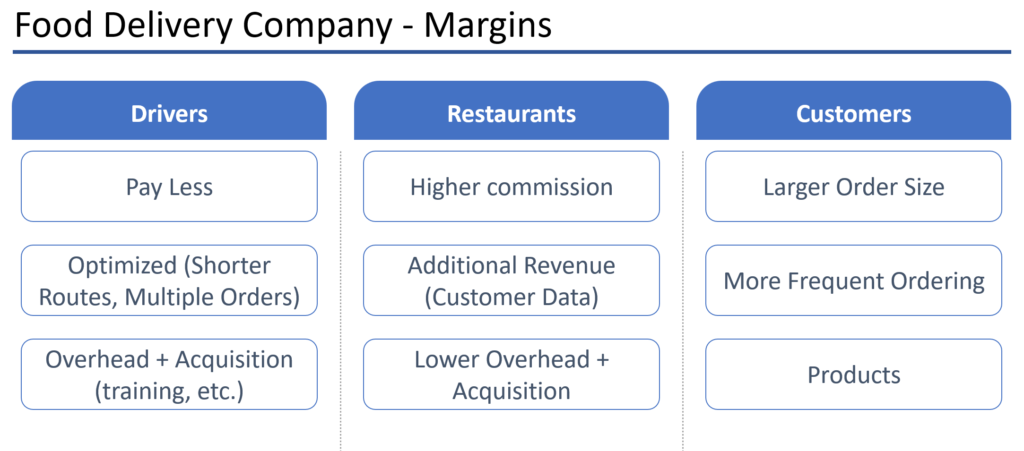 This probably looks different to what you expected. But it’s also why my candidates consistently get interviewer feedback saying their frameworking is the best they have ever seen. Remember, every profitability case should have a slightly different set of buckets, based on the problem you are solving. Again, for a deeper breakdown, check out our article here .  Applying the Profitability Framework To apply the profitability framework effectively, follow these steps:
When identify which areas to pursue (across profit, margin, revenu, and cost), you want to tackle any of the following:
 Market Entry Case Frameworks The market entry framework is used to evaluate the attractiveness and feasibility of entering a new market or launching a new product. It helps consultants assess the potential opportunities and risks associated with market entry and develop a comprehensive strategy for successful market penetration. Key Components of the Market Entry Framework Just like with profitability, you have to tailor your framework to the case prompt. One option for a market entry framework is as follows:
But, the above is just one option. We could also have a Market, Company/Competition, and Financials framework. However, ideally we would articulate it as follows: 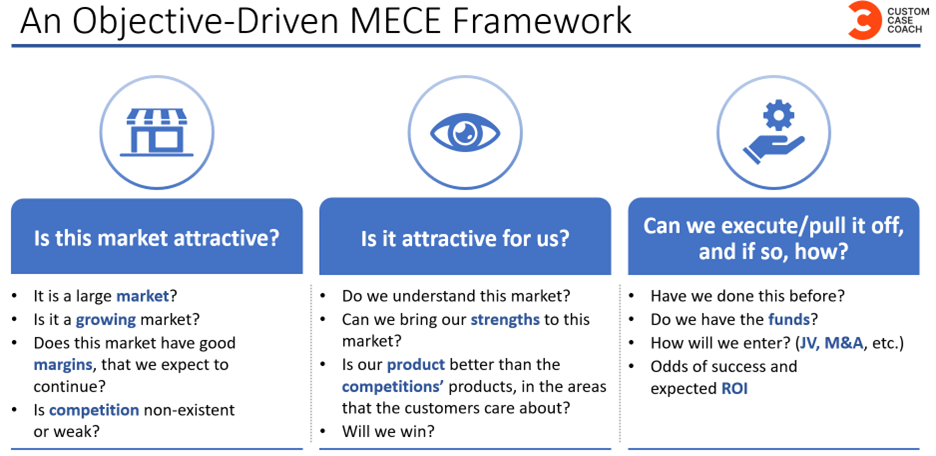 Now, remember that all of the above is just for the question Should We Enter This Market? A different market entry question might be “Our Client has determined that x market is attractive and wants to enter. They have brought us to figure out if we should”. This needs a different framework. Or, the question might be “Our client has decided to enter x market. How should we enter?” The above frameworks don’t work here! As a final example, perhaps the case tells us “We are evaluating between 3 markets to enter. Which one should we enter?” Again, new framework needed. To understand how to tackle these more unconventional market entry cases, please take a look at our 360 degree course . The Porter's Five Forces Case FrameworkPorter’s Five Forces is a widely recognized case study framework developed by Harvard Business School professor Michael E. Porter. It helps consultants analyze the competitive forces shaping an industry and understand the attractiveness and profitability of a market. Key Components of Porter’s Five Forces Framework The Porter’s Five Forces framework consists of five main components:
When to Use Porter’s Five Forces Framework The Porter’s Five Forces framework is most applicable in cases where the client is considering entering a new market, launching a new product, or assessing the competitive landscape of an industry. Applying Porter’s Five Forces Framework To apply the Porter’s Five Forces framework effectively, follow these steps:
The SWOT Analysis Framework The SWOT analysis is a widely recognized case study framework that helps consultants evaluate a company’s internal strengths and weaknesses as well as external opportunities and threats. This framework enables consultants to identify key strategic issues and develop recommendations to address them. Key Components of the SWOT Analysis Framework The SWOT analysis framework consists of four main components:
When to Use the SWOT Analysis Framework The SWOT analysis framework is most applicable in cases where the client is seeking to improve its overall performance or address specific strategic issues. Applying the SWOT Analysis Framework To apply the SWOT analysis framework effectively, follow these steps:
Growth Case Frameworks The growth strategy framework focuses on identifying and evaluating potential avenues for a company to achieve revenue and market share growth. This framework helps consultants develop a strategic roadmap for the client’s expansion and growth. Key Components of the Growth Strategy Case Framework One growth strategy case framework can be broken down into four main components:
Remember, however, just like with profitability and market entry cases, you need to listen to the prompt and adjust this framework accordingly to the prompt and company context. Different growth prompts will have different case frameworks. When to Use the Growth Strategy Case Framework The growth strategy framework is most applicable in cases where the client is seeking to expand its business, increase market share, or explore new growth opportunities. Applying the Growth Strategy Framework To apply the growth strategy framework effectively, follow these steps:
Tips for Successfully Applying Case Study FrameworksTo effectively apply case study frameworks in your consulting practice, consider the following tips:
Enroll in our 360 course . This comprehensive course focuses heavily on building up your frameworking optimally. To get a better understanding of how to create killer case frameworks, start with our master article on case frameworks. Mastering case study frameworks is crucial for success in the consulting industry. By understanding the key components, applications, and best practices for applying these frameworks, you can develop a strong foundation for effective problem-solving and strategic thinking. Remember to stay flexible, adaptable, and customer-centric in your approach, and always be prepared to learn and grow as you refine your skills in applying case study frameworks. By doing so, you can unlock unparalleled insights and deliver exceptional value to your clients and interviewers alike. Recommended For YouWant to learn how to become a master in frameworking? Found this article useful? We recommend the following to help you level up and get that offer:  The World of Frameworks 360° Course 4. Case InterviewAdditional articles.
 Stay Ahead of the Game: Your Ultimate Consulting Recruiting Timeline for 2024 How to Get a Consulting Internship – Tips and Tricks How to Answer ‘Why Consulting?’ in Interviews: A Comprehensive Guide Navigating the McKinsey Interview Process in 2023: Mastering Interviewer Led Case Interviews How to Answer “Walk Me Through Your Resume” – Comprehensive Guide with Sample Answers Data Driven Recruiting (Part 2 – Invite-Only Events)Insert/edit link. Enter the destination URL Or link to existing content Career in Consulting 11 must-know case interview frameworksThis is a complete guide to case interview frameworks. In this in-depth guide, you’ll learn:
So, if you want to land an offer from a top consulting firm, this guide is for you. Let’s dive right in. Table of ContentsGet the latest data about salaries in consulting, what are case interview frameworks. A case interview framework is a structured way to approach how to solve a problem . In other words: Case interview frameworks help Consultants (and aspiring Consultants) brainstorm and organize their ideas to solve complex problems. For example, a case interview framework is the profitability framework. Let’s imagine this business problem: Your client is manufacturing cars. And, for the past 2 years, they have been experiencing declining profits. They hire us to determine the root causes of this business problem. And to help this company, you should explore the two main profit drivers: revenues and costs. 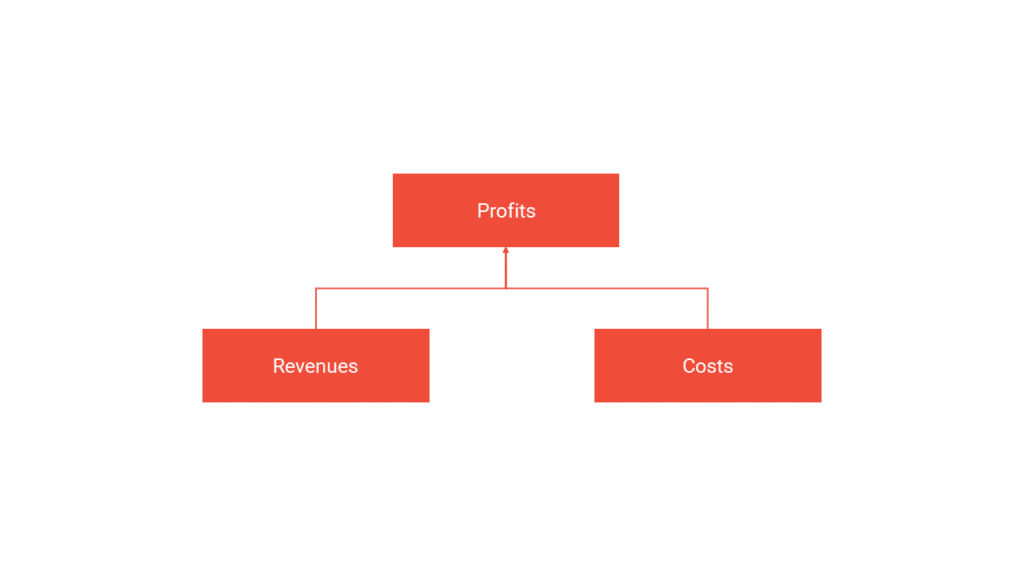 And explore if revenues decreased (one cause of declining profits). Or explore if costs increased (another cause of declining profits). Well… this (simple) example is a business framework. Related articles Check also these articles to ace your case interviews: 16 case interview tips 16 case interview mistakes Ace market sizing questions (incl. 3 market sizing frameworks) Case interview preparation 280 case interview examples Let’s detail the 11 common case interview frameworks you must know to ace your case interviews . And let’s start with Porter’s five forces. Case interview framework 1: Porter’s Five ForcesLet’s start with an analysis of external factors. And one of the most well-known business frameworks is Michael Porter’s Five Forces model. And it can be found in the book Competitive Strategy: Techniques for Analyzing Industries and Competitors . Michael Porter’s Five Forces model says the following: Competitive advantage in an industry is dependent on five primary forces :
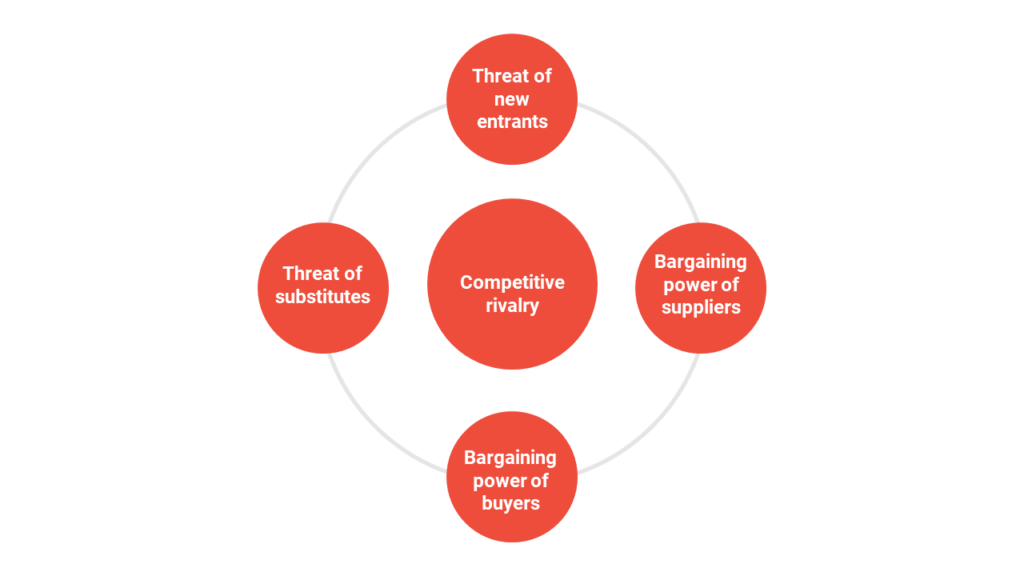 The degree of these threats determines the attractiveness of the market:
Therefore, the goal is to assess whether a company should enter/exit the industry or find a position to defend itself against these forces best or influence them in its favor . For instance, your market entry framework should include the components of Porter’s Five Forces. The threat of new entrants (barriers to entry)Several factors determine the degree of difficulty in entering an industry:
Product differentiation
Relationship with buyers (buyer power)
Relationship with suppliers (supplier power)A supplier group is powerful if:
Key issues in purchasing strategy from a structural standpoint are as follows:
Substitute productsSubstitute products that deserve the most attention are those that:
Rivalry among competitors (competitive analysis)Now, let’s analyze the competitive landscape. Rivalry among existing competitors increases if:
To end this first section about Porter’s Five Forces, you can watch this video made by the channel Business To You. Case interview framework 2: the 4 P’sThe 4Ps are: And it’s often seen as a Marketing framework. 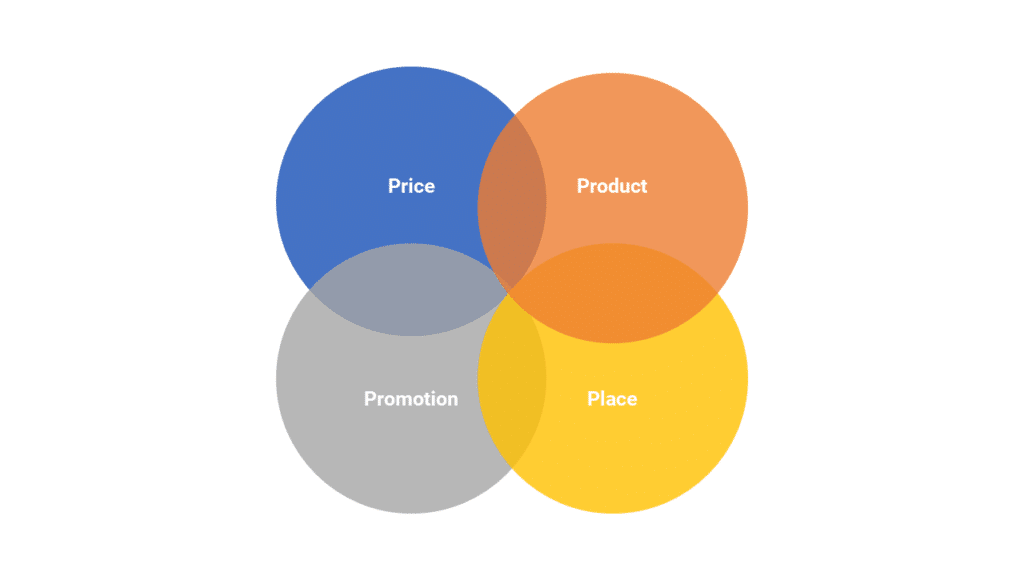 The 4Ps framework can help you in your case interviews in one of the following situations :
Now, let’s look at the different elements of the 4P framework. In examining the competitiveness of a company’s product, whether it is a new product being introduced on the market or an existing product manufactured by the company, one must examine the product itself. The following are some of the questions you might find helpful in assessing a product’s competitiveness :
Getting the right price for a product is extremely important for the company’s success. Unfortunately, sometimes the right price is not easy to determine. Depending on the price elasticity of the product, a 1% increase in price has anywhere from a -20% reduction to a 25% increase in net income. The most important factor that drives price is the customer’s perceived “value” of the product . This is also known as the customer’s willingness to pay. For example, if a company produces shirts with a unit cost of $10, but the market perceives the product as fashionable or has the right brand name, the shirt can be priced to capture any consumer surplus at $50 or even $80 per shirt. The same manufacturer introduces another shirt at the same cost the following season. This time, however, the shirt is no longer considered in vogue and thus has little “value.” This time, the shirt would be priced at $25. Other factors determining a product’s price are:
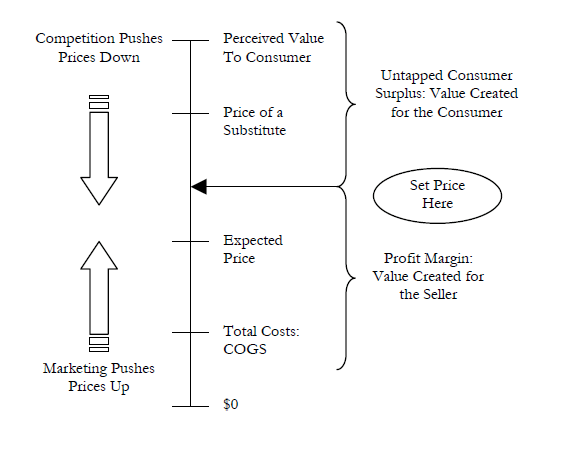 After assessing the product positioning and understanding who your customers are, you need to develop a strategy around which distribution channel to use and where to sell your product . The distribution channel can be through a third party or an in-house sales force. And the distribution channel is responsible for transmitting the company’s product to the customer (wholesaler, retailer, end-user). The selected distribution channel and the outlets at which the product is sold MUST be aligned with the product’s positioning and focused customer segment. There are many issues to consider when examining the place/channel distribution. Below are some thoughts to formulate a strategy for delivering the product to market :
Promoting and developing a specific brand for the product has many benefits : It develops a certain perception of the product in consumers’ eyes. The product’s success will depend on the message conveyed to the consumer and what that consumer ultimately believes about the product. To maintain a certain perception of exclusivity, traditional advertising (mass or niche), refraining from advertising, word-of-mouth marketing, direct mail, etc., can all be included in promotion and branding. Here is a list of issues worth analyzing in case interviews:
Ace market sizing questions Case interview framework 3: the 3 C’sKnowing the 3C framework and the details upon which the framework is based is crucial to cracking the case . For instance, the 3C framework is often used to assess the business landscape. Or by simply defining a growth strategy. For instance, your market entry framework should include the 3C’s. 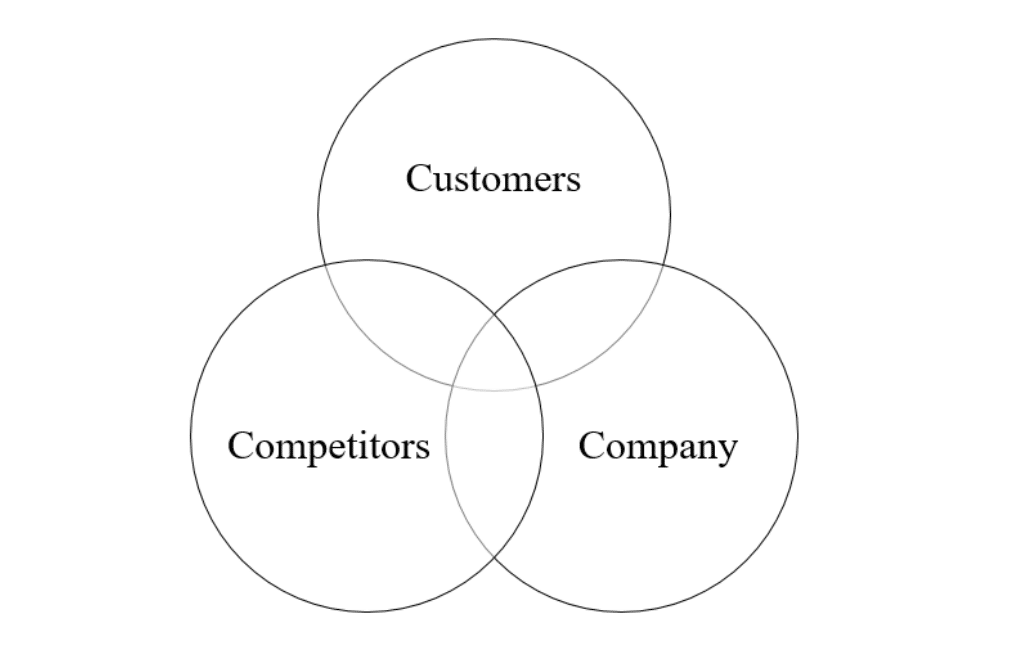 By analyzing the three elements, Consultants can identify the key success factors and create a viable marketing strategy. DO NOT attempt to tackle a case during the interview by saying, “I would like to use the 3Cs framework…” Before you even finish your sentence, the interviewer will have decided to reject you. This point will be emphasized many times during this guide. A good first step in assessing the business landscape is to examine the customer, the people whose problems the industry is trying to solve. Below are eight factors to consider when examining the customer. 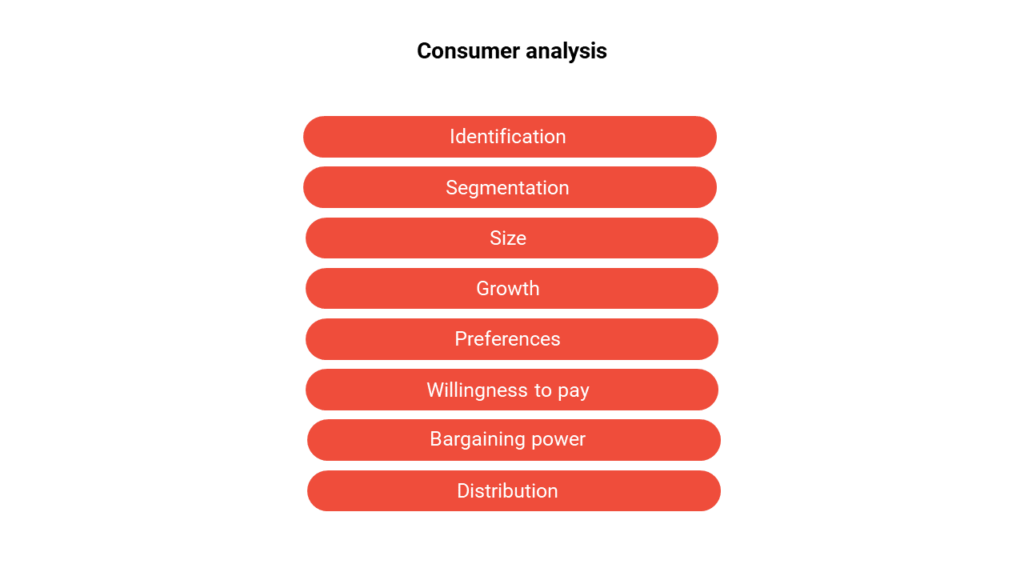 #1: Customer IdentificationWho is the customer? In trying to identify the customer, remember that the person who makes the purchase decision, the person who pays (the customer), and the end user (the consumer) may all be different people. For example, a doctor may prescribe medicine that will be paid for by an insurance company (the customer) and ultimately used by a patient (the consumer). #2: Customer SegmentationIs it possible to group customers into distinct segments? Customer segmentation can make it easier to understand customer needs and preferences, the size and growth rate of different revenue streams, and to identify trends. It may make sense to segment customers by: 1. Age group 2. Gender 3. Income level 4. Employment status 5. Distribution channel 6. Region 7. Product preference 8. Willingness to pay 9. New versus existing customers 10. Large versus small customers. How big is the market? How big is each customer segment? How many customers are there in each segment, and what is the dollar value of those customers? How fast is the market growing? What is the growth rate of each customer segment? #5: Customer PreferencesWhat do customers want? Do different customer segments want different things? Are the needs and preferences of customers changing over time? #6: Willingness to PayHow much is each customer segment willing to pay? How price sensitive is each customer segment? For example, students will normally be very price sensitive, which means that offering student discounts can increase units sold by enough to increase total revenue. #7: Bargaining PowerWhat is the concentration of customers in the market relative to the concentration of firms? If there is a small number of powerful customers who control the market? Then it may be necessary to either play by their rules or search for a more favorable market. Do customers face high switching costs? If customers face high switching costs, this will reduce their bargaining power and allow firms to charge higher prices than would otherwise be possible. #8: DistributionWhat is the best way to reach customers? Does each customer segment have a preferred distribution channel? Get 4 Complete Case Interview Courses For Free You need 4 skills to be successful in all case interviews: Case Structuring, Case Leadership, Case Analytics, and Communication. Join this free training and learn how to ace ANY case questions. CompetitorsIt is also important to understand the business landscape to understand the competition . Competition can come from firms within an industry offering similar solutions to the same group of customers (for example, Pepsi and Coca-Cola). But, competition can also come from firms in other industries who produce substitutes . Substitutes may have quite different characteristics (for example, petroleum and natural gas). Still, they represent a form of indirect competition because consumers can use them in place of one another (at least in some circumstances). For example, petroleum and natural gas might produce heat and energy. Below are ten factors to consider when examining the competition. 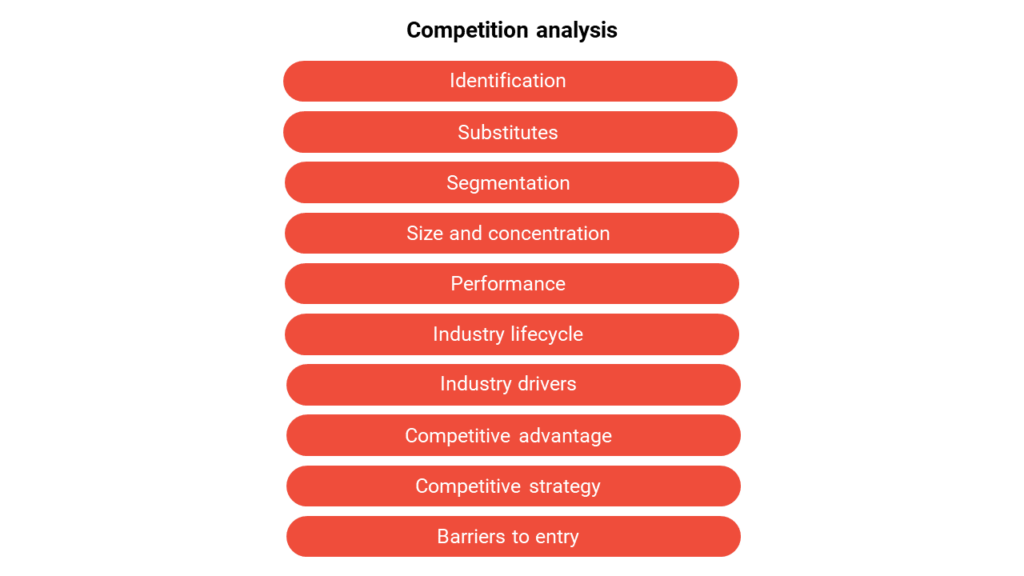 #1: Competitor IdentificationWho are the company’s major competitors? Taking Cadbury as an example, some of its major competitors might include Lindt, Ferrero, Nestlé, Hershey’s, and Mars. What products and services does the competition offer? #2: SubstitutesWho are the company’s indirect competitors? That is, which firms are producing substitutes? Identifying indirect competitors helps to take a broader view of what the company offers. For example, Cadbury sells chocolate. But it might be considered a snack food company. So indirect competitors might include companies like Lays, Cheetos, and Doritos. #3: Competitor SegmentationIs it possible to segment competitors in a meaningful way? The competition might be grouped by distribution channel, region, product line, or customer segment. #4: Size and ConcentrationWhat are the revenues and market shares of major competitors? What is the concentration of competitors in the industry? Are there many small competitors (a low-concentration industry) or a few dominant players (a high-concentration industry)? Examples of high-concentration industries include oil, tobacco, and soft drinks. Examples of low-concentration industries include wheat and corn. #5: PerformanceWhat is the historical performance of the competition? Relevant performance can be profit margins, net income, and return on investment. #6: Industry LifecycleWhere is the industry’s lifecycle (early stage, growth, maturity, or decline)? #7: Industry DriversWhat drives the industry: brand, product quality, the scale of operations, or technology? #8: Competitive AdvantagesWhat is the competition good at? How sustainable are these advantages? What are the competition’s weaknesses? How easily can these weaknesses be exploited? #9: Competitive StrategyWhat strategy is the competition pursuing? Is the competition producing products that are low-cost or differentiated? What customer segments is the competition targeting? What are the competition’s pricing and distribution strategies? What is the competition’s growth strategy? Are they seeking growth by focusing on customer retention, increased sales volume, entering new markets, or launching new products? #10: Barriers to entryKey barriers to entry include capital requirements, economies of scale, network effects, product differentiation, proprietary product, technology, government policy, access to suppliers, access to distribution channels, and switching costs. (see Porter’s five forces model). In assessing the business landscape, it is not enough to understand the customer and the competition. Understanding the firm from whose perspective you are analyzing the industry is also important . Below are ten factors to consider when examining the company. 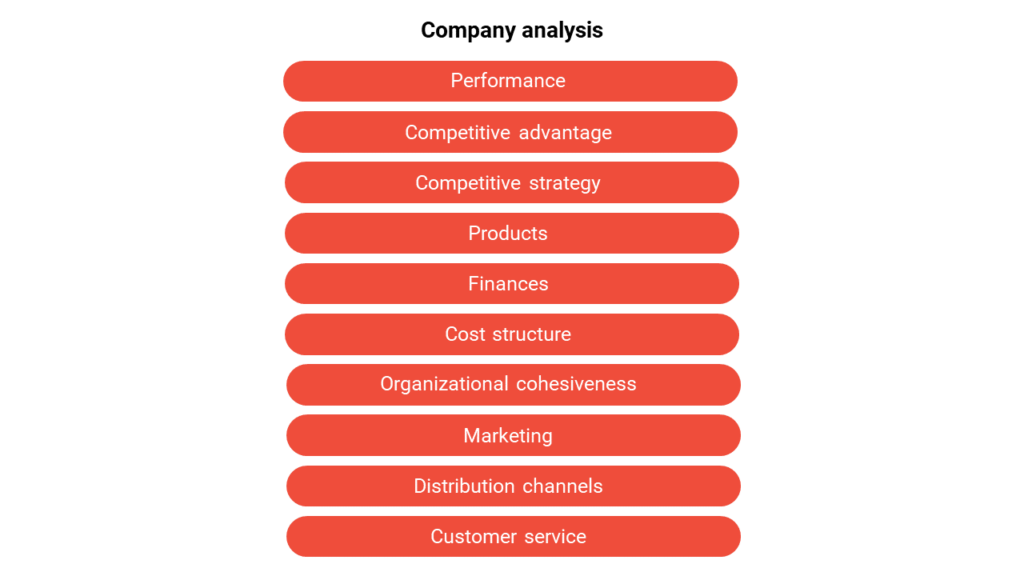 #1: PerformanceWhat is the historical performance of the company? What is its market share? If profits are falling, what is the cause of the issue? #2: Competitive AdvantageWhat resources and capabilities does the company possess? Consider tangible assets (property, plant, equipment, inventory, and employees) and intangible assets (brand, patents, copyrights, and specialized knowledge). How sustainable are the company’s advantages? What are the company’s weaknesses, and can they be remedied? #3: Competitive StrategyWhat is the company’s competitive strategy? Is the company producing products that are low-cost or differentiated? Which customer segments does the company target? What are the company’s pricing, distribution, and growth strategies? #4: ProductsWhat does the company offer, and how does it benefit consumers? Does the product have any downsides or side effects? Is the product differentiated? How does the company’s product offering compare with the competition? Are there substitutes available? #5: FinancesIf the company is considering a particular course of action, does it have sufficient funds available? Financing may be secured from various sources, including internal cash reserves, bank loans, shareholder loans, bond issues, or the sale of shares. How many units will the company need to sell to cover the cost of the project? Is there sufficient market demand? #6: Cost StructureTo understand a company’s cost structure, it helps to break each business unit down into the collection of activities performed to produce value for customers. How each activity is performed, and its economics will determine a firm’s relative cost structure within its industry. Are costs predominantly fixed or variable? How does this compare with the competition? #7: Organisational CohesivenessUnderstanding a firm’s inner workings is important since competitive strategies can fail if they conflict with its culture, systems, and general business. The organizational aspects of a firm can be examined using the McKinsey 7 S Model. #8: MarketingHow do customers perceive the company and its products? How does the company communicate with customers? #9: Distribution ChannelsWhat distribution channels does the company use to reach customers? Are there other channels that are more cost-effective or preferred by customers? #10: Customer ServiceDoes the company have a customer loyalty program? How does the company interact with customers and support its customers post-sale? Are employees empowered to solve problems and delight customers? Case interview framework 4: PESTEL (or PESTLE)PESTEL is an acronym for five factors – Political, Economic, Social, Technological, Legal, and Environmental – that can influence a company’s performance or strategic decisions. 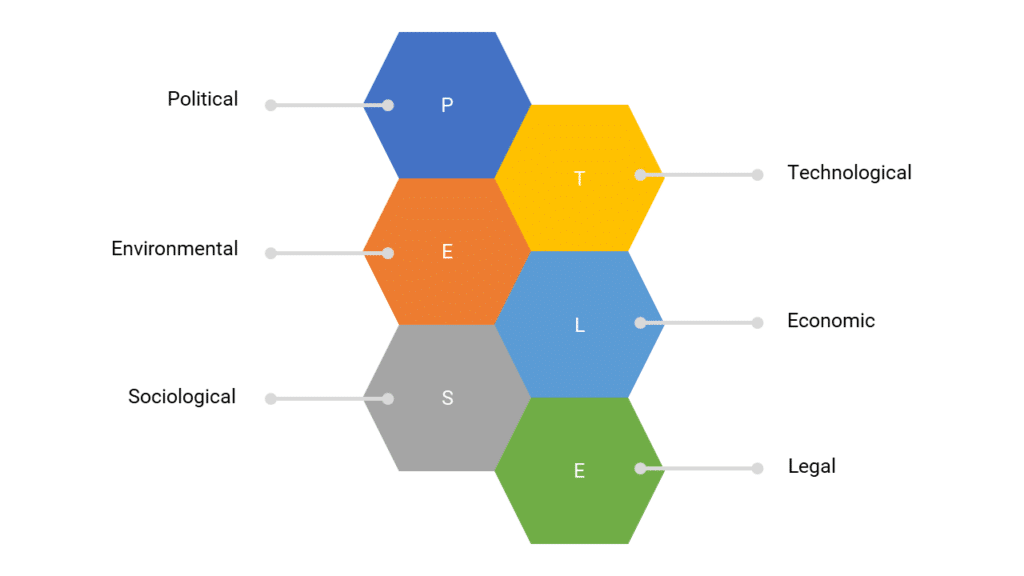 A PESTEL analysis examines these external forces that can have strategic implications for the company . And conducting a PESTEL analysis can be helpful for three reasons: Understanding the facts : Understanding the big picture can help a business make informed decisions and avoid incorrect assumptions based on past experience. Anticipating change : Understanding the macro environment can help a business identify trends and anticipate change, allowing it to take advantage of opportunities and manage potential threats. Avoiding failure : Understanding the macro environment can help a business (and its investors) to identify projects that are likely to fail due to unfavorable conditions. Below is a list of some of the general issues the interviewee should consider: Political forces
Economic factors
Socio-cultural forces
Technological factors
Environmental factors
Legal factorsFinally, the folks from the YT channel Business To You have made a great video about the PESTLE model: Case interview framework 5: Profitability frameworkThere’s a good chance that the cases discussed during the interview will often touch on issues of declining profitability . This framework is very helpful in organizing your thoughts and methodically approaching profitability problems. According to the Profitability Framework’s opening statement, profit is a function of revenue and costs. A company’s profitability declines when revenue has dropped, costs have risen, or both. The goal is to identify the component of the equation that is reducing profitability and determine the best course of action for fixing it. 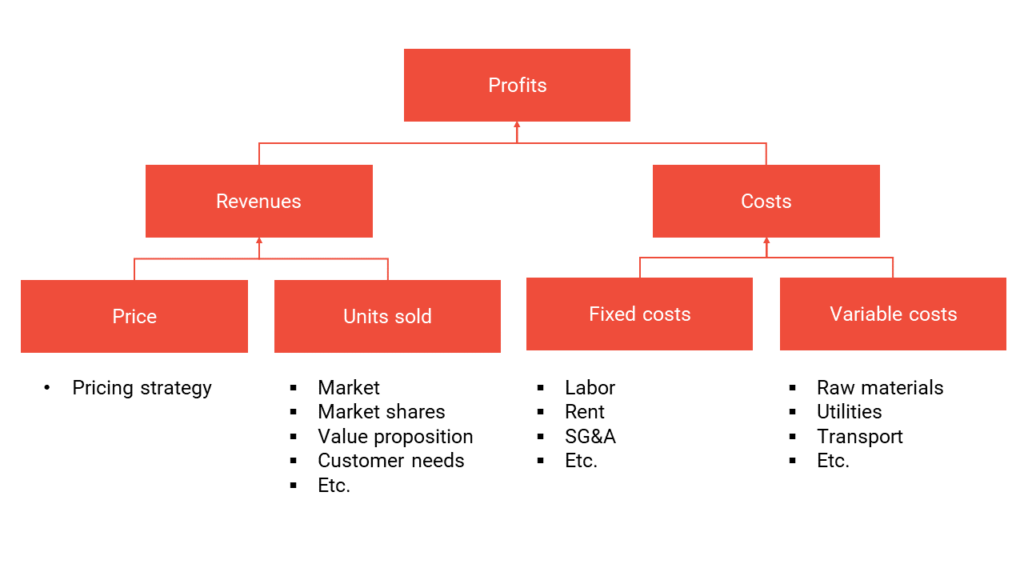 A quick note: Variable costs are costs that vary with the units sold. Fixed costs are costs that do not vary with the units sold. Case interview framework 6: Unit contributionThe following is a framework you can use to help you understand the economics of the product’s contribution. This framework is critical when forecasting the overall success of the product . 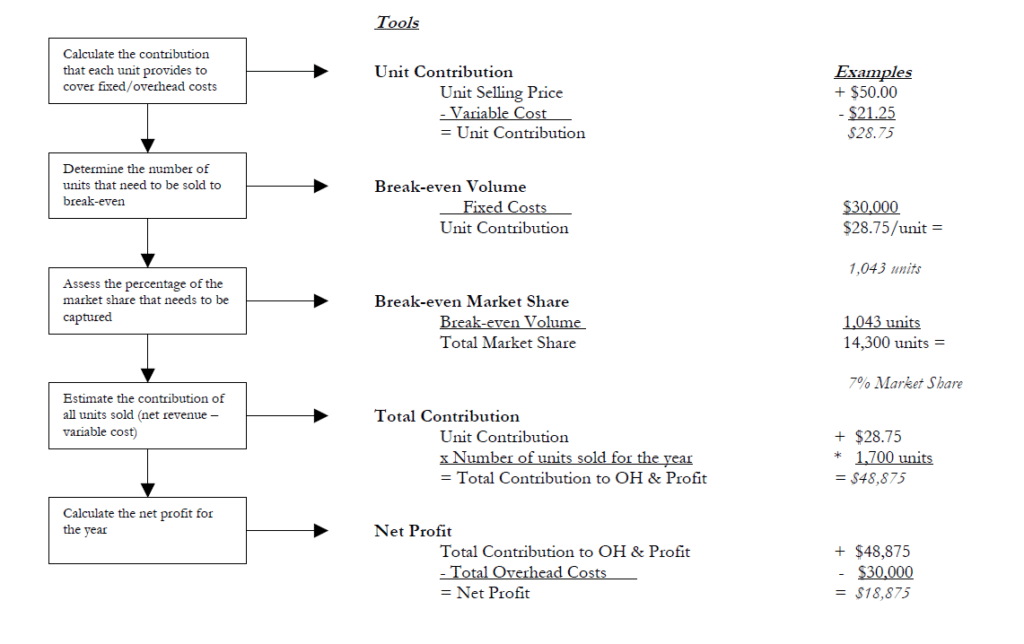 Case interview framework 7: Break EvenA break-even analysis tells you how many units of a product must be sold to cover the fixed and variable production costs. For instance, this is important when deciding whether to launch a new product. 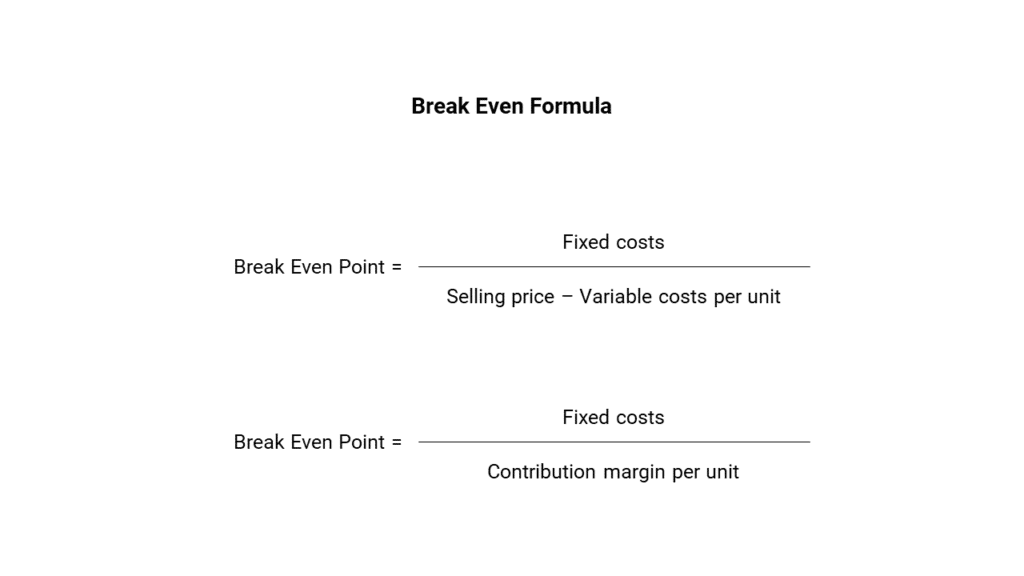 Also, a break-even analysis concerns a product’s contribution margin (selling price minus variable costs per unit; see the previous section). So, the contribution margin is the excess between the selling price of the product and the total variable costs . For example, if an item sells for $100, the total fixed costs are $25 per unit, and the total variable costs are $60 per unit, the product’s contribution margin is $40 ($100 – $60). This $40 reflects the revenue collected to cover the remaining fixed costs, which are excluded when figuring the contribution margin. Case interview framework 8: ROIROI is an acronym for Return On Investment. The ROI is a performance measure that a company can use to evaluate the return from an investment or to compare the returns of several different investments .  For example, if you spent $10,000 and made $15,000, your ROI would be 50%. [ ( $15,000 – $10,000 ) / $10,000 ] x 100% = 50% Case interview framework 9: PaybackA payback period is the time needed to recover the cost of an investment. Simply put, it is the time an investment reaches a breakeven point . For example, if a company invests $300,000 in a new production line, and the production line then produces a positive cash flow of $100,000 per year, then the payback period is 3 years. 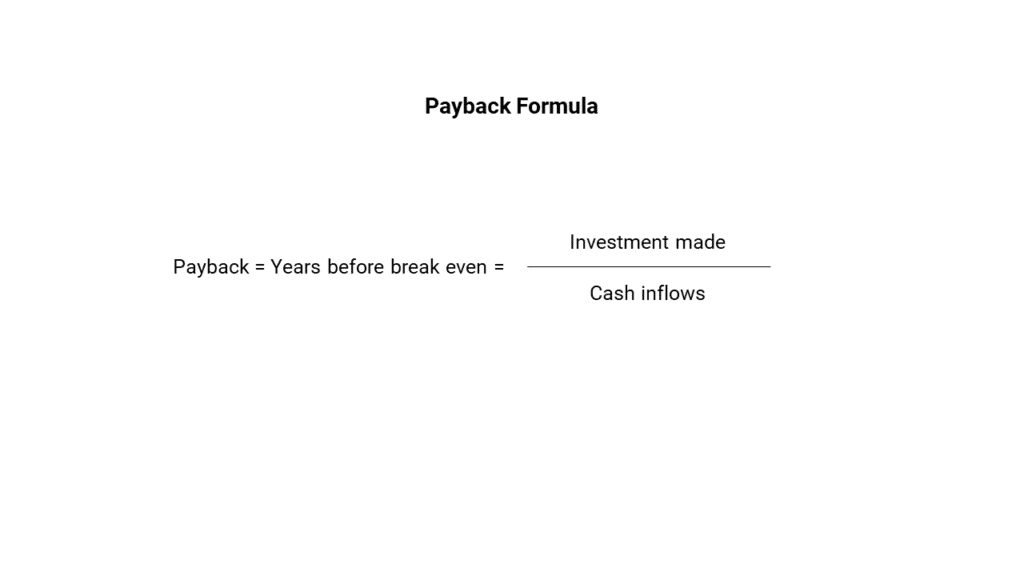 Another example: You are offered to invest in the project $120K. The project will bring on average $30K a year in net profit. Using the payback formula, we get a payback period for capital invested of four years (we divided 120,000 by 30,000). Case interview framework 10: Value ChainA Value Chain Analysis is a concept first described and popularised by Michael Porter in his 1985 book, Competitive Advantage . Value Chain Analysis involves identifying all the important business activities and determining which ones give the company a competitive advantage . Also, a value chain analysis can be performed to identify potential root causes of a business problem. 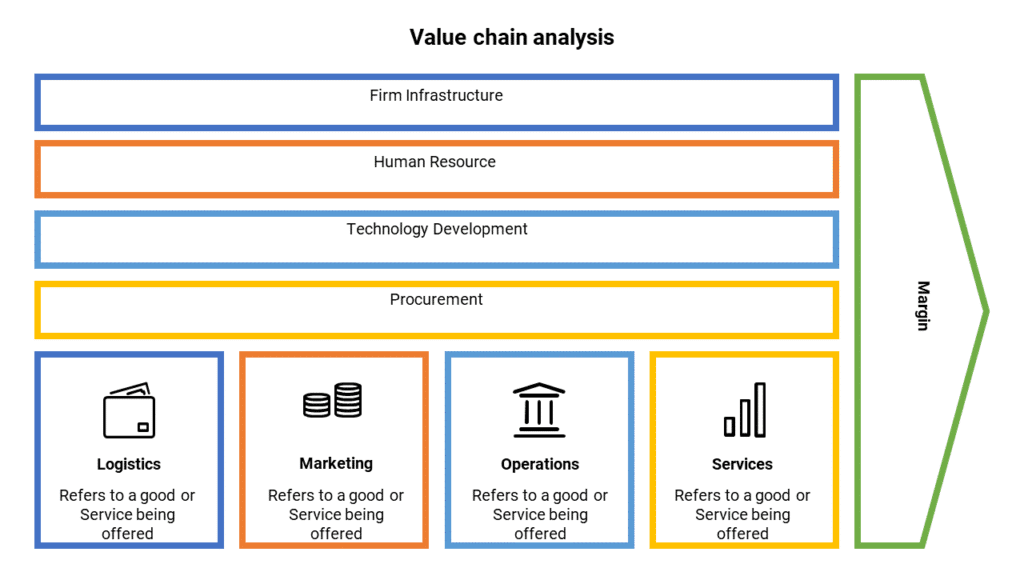 For instance, a Value Chain Analysis can be undertaken by following three steps:
Cost advantageA business can achieve a cost advantage over its competitors by understanding the costs associated with each activity. And then organizing each activity so that it is as efficient as possible. Porter identified ten cost drivers related to each activity in the value chain : 1. Economies of Scale 2. Learning 3. Capacity utilization 4. Linkages among activities 5. Interrelationships among business units 6. Degree of vertical integration 7. Timing of market entry 8. Firm’s policy on targeting cost or product differentiation 9. Geographic location 10. Institutional factors (regulation, union activity, taxes, etc.) A firm can develop a cost advantage by controlling these ten cost drivers better than its competitors. A firm can achieve product differentiation by focusing on its core competencies to perform them better than its competitors . Product differentiation can be achieved through any part of the value chain. For example, procurement of unique inputs and not widely available to competitors, providing high levels of product support services, or designing innovative and aesthetically attractive products. Case interview framework 11: Ansoff MatrixThe Product/Market Expansion Matrix (or “Ansoff Matrix” as it is sometimes called) was developed by a Russian-American mathematician named Igor Ansoff. And it was first explained in his 1957 Harvard Business Review article entitled Strategies for Diversification. The Product/Market Expansion Matrix can help a firm define a product-market growth strategy by focusing on four growth alternatives : 1. Market Penetration; 2. Market Development; 3. Product Development; and 4. Diversification. 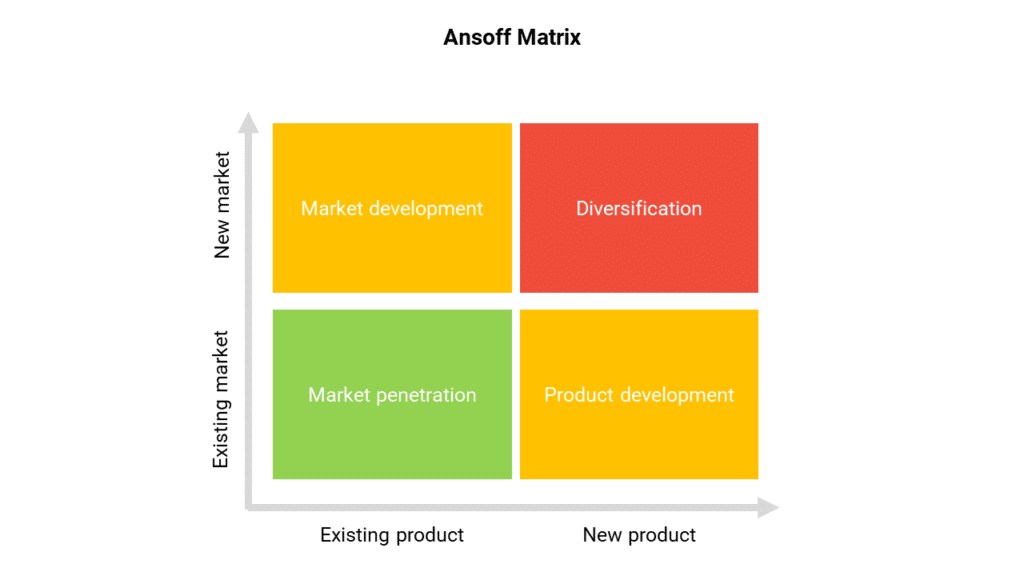 The four alternative growth strategies are: Market Penetration : A strategy to increase sales without departing from the original product-market strategy. This involves increasing sales to existing customers and finding new customers for existing products. Market Development : A strategy to sell existing products to new markets (normally with some modifications). Ansoff described this as a strategy “to adapt [the] present product line … to new missions.” For example, Boeing might adapt a passenger aircraft model for cargo transportation. Product Development : A strategy to sell new products, with new or altered features, to existing markets. Ansoff described this as a strategy to develop products with “new and different characteristics such as will improve the performance of the [existing] mission.” For example, Boeing might develop a new aircraft design with improved fuel economy. Diversification : A strategy to develop new products for new markets, which can be related to the current business (e.g., vertical integration or horizontal diversification) or unrelated (e.g., conglomerate diversification). Learn how to create custom case interview frameworksThe question then becomes, “How do you use business frameworks in consulting interviews?”. On the Internet, numerous suggestions exist for how you ought to proceed. However, the two main schools of thought are Victor Cheng’s frameworks and Marc Cosentino’s Case In Point. However, these two approaches have one thing in common: they both attempt to impose pre defined frameworks on cases . For instance: For a market entry case, those resources tell you the market entry framework you should use. And for an M&A case, those resources tell you exactly the merger and acquisition framework you should use. They push you to adapt the problem to your tools . Since every case is different, this will inevitably result in average outcomes and rejections. For instance, 10 different M&A cases should have 10 different merger and acquisition frameworks. Another example: 10 different market entry cases should have 10 different market entry frameworks. So, you have to learn how to create custom case interview frameworks. You must create your own unique frameworks using First Principle Thinking . Those case interview frameworks must be MECE . To do so, I’ve created free training to help you in that journey . You can sign up for free with the link below. Case interview frameworks: Final wordsI hope you enjoyed this updated guide to business frameworks. Those consulting frameworks will help you join a top consulting firm. Now, I’d like to hear from you: Which frameworks from today’s guide do you use the most? Or which frameworks are new to you? Has this guide helped you develop your business acumen? Let me know by leaving a quick comment below right now. To your success, P.S. Need help with your case interview preparation? Check whether our coaching program is a good fit. Do you know? We have a unique coaching model and deliver amazing results . SHARE THIS POST Leave a Comment Cancel ReplyYour email address will not be published. Required fields are marked * You need 4 skills to be successful in all case interviews: Case Structuring, Case Leadership, Case Analytics, and Communication. Enroll in our 4 free courses and discover the proven systems +300 candidates used to learn these 4 skills and land offers in consulting.  |
IMAGES
VIDEO
COMMENTS
In a market entry case interview, you are expected to evaluate an expansion opportunity (entry into new markets, new segments or new product lines in existing markets), decide whether the client company should pursue it, and, if yes, suggest an entry strategy. The underlying principle of the market entry framework is based on this process.
Learn the five steps to solve any market entry case and the perfect market entry framework to use.
Tips On Using The Market Entry Case Framework. 1. Look for market entry cases buried inside other types of case study interviews. If a company is looking for growth, market entry is one way they might achieve it, so your revenue growth case could turn into a new product or new geographic market case. 2.
Learn how to apply the market entry framework in case interviews, types of market entry questions, and example case interview questions.
Market entry cases are a recurring theme in the management consulting interview process. This is because consultants will frequently deal with market entry when working on real projects - which in turn means they are likely to base interview case studies on recent market entry work. Releasing new products and entering new markets is ...
Case Interview Frameworks: The Ultimate Guide (2024) Case interview frameworks or consulting frameworks are arguably the most critical component of a case interview. Outstanding case frameworks set you up for success for the case while poor frameworks make the case difficult to solve.
The ultimate guide to Case Interview Frameworks. Market sizing, market entry, profitability, M&A, and more frameworks explained!
Use the following five steps to approach a market entry case. 1. Paraphrase and clarify the objective at the beginning (same as all other cases) As usual, take good notes! Start with paraphrasing the problem and clarify all questions to make sure you understand the problem.
Explore our comprehensive guide on the market entry framework, covering key strategies for successful market expansion, including market analysis, entry tactics, product adaptation, and more. Perfect for businesses seeking to navigate new markets effectively.
To continue our series on case interview frameworks, we bring you our personal favorite - and the most versatile - the Market Study case interview framework.
An overview of market entry cases, including different types of market entry cases, a framework for approaching the case and a full market entry case example.
It modified its entry strategy and performance expectations accordingly. 5. Using the reference class to set reasonable bounds on market share estimates also helps. If the reference class attained only a 3 to 5 percent market share, decision makers should pause when they see higher estimates.
List of consulting frameworks, including explanations of each one. Plus a step-by-step guide for creating custom frameworks during case interviews.
Either way, both questions follow the same structure in the beginning. The market entry framework used in this example covers a company characteristics analysis, industry analysis and an entry-mode vehicle selection.
The market entry framework is a tool designed specifically to help you analyze the potential success of new products. This includes understanding the barriers to market entry, including product development costs, regulatory requirements, and distribution issues.
A well-crafted market entry strategy is crucial to successfully penetrate foreign markets. This article explores various market entry strategies, their potential benefits, and considerations, supported by relevant examples and case studies.
In conclusion, the market entry strategy framework is an easy way to understand the process of entering new markets. It helps you identify the right markets for your product or service. Additionally, the framework can help you assess the risks and opportunities associated with entering a new market. Finally, the framework can help you develop a ...
Market entry strategy frameworks can be used to crack consulting case interviews. We step through a market entry case study and provide an example solution.
The market entry framework is an essential tool for consultants in helping businesses to succeed in new markets. By providing a structured and comprehensive approach to market entry, the framework helps businesses to identify opportunities, mitigate risks, and develop effective strategies.
The market entry framework is used to evaluate the attractiveness and feasibility of entering a new market or launching a new product. It helps consultants assess the potential opportunities and risks associated with market entry and develop a comprehensive strategy for successful market penetration.
Case interview framework 1: Porter's Five Forces. Let's start with an analysis of external factors. And one of the most well-known business frameworks is Michael Porter's Five Forces model. And it can be found in the book Competitive Strategy: Techniques for Analyzing Industries and Competitors.
Tips On Using The Market Entry Case Framework 1. Look for market entry cases buried inside other types of case study interviews. If a company is looking for growth. market entry is one way they might…
The case interview mergers & acquisitions framework explained. Learn how to expertly apply the M&A framework in a case interview setting!